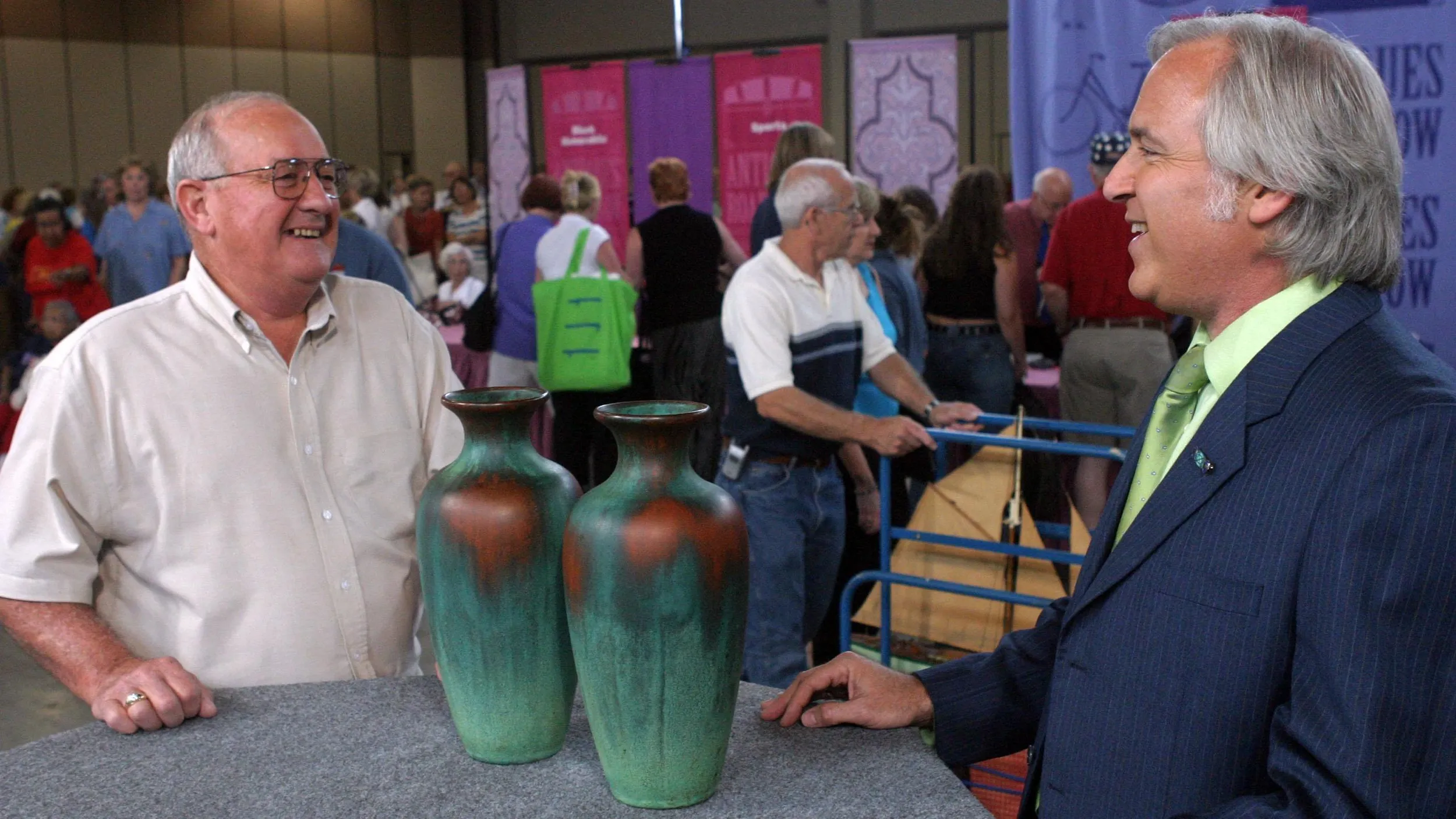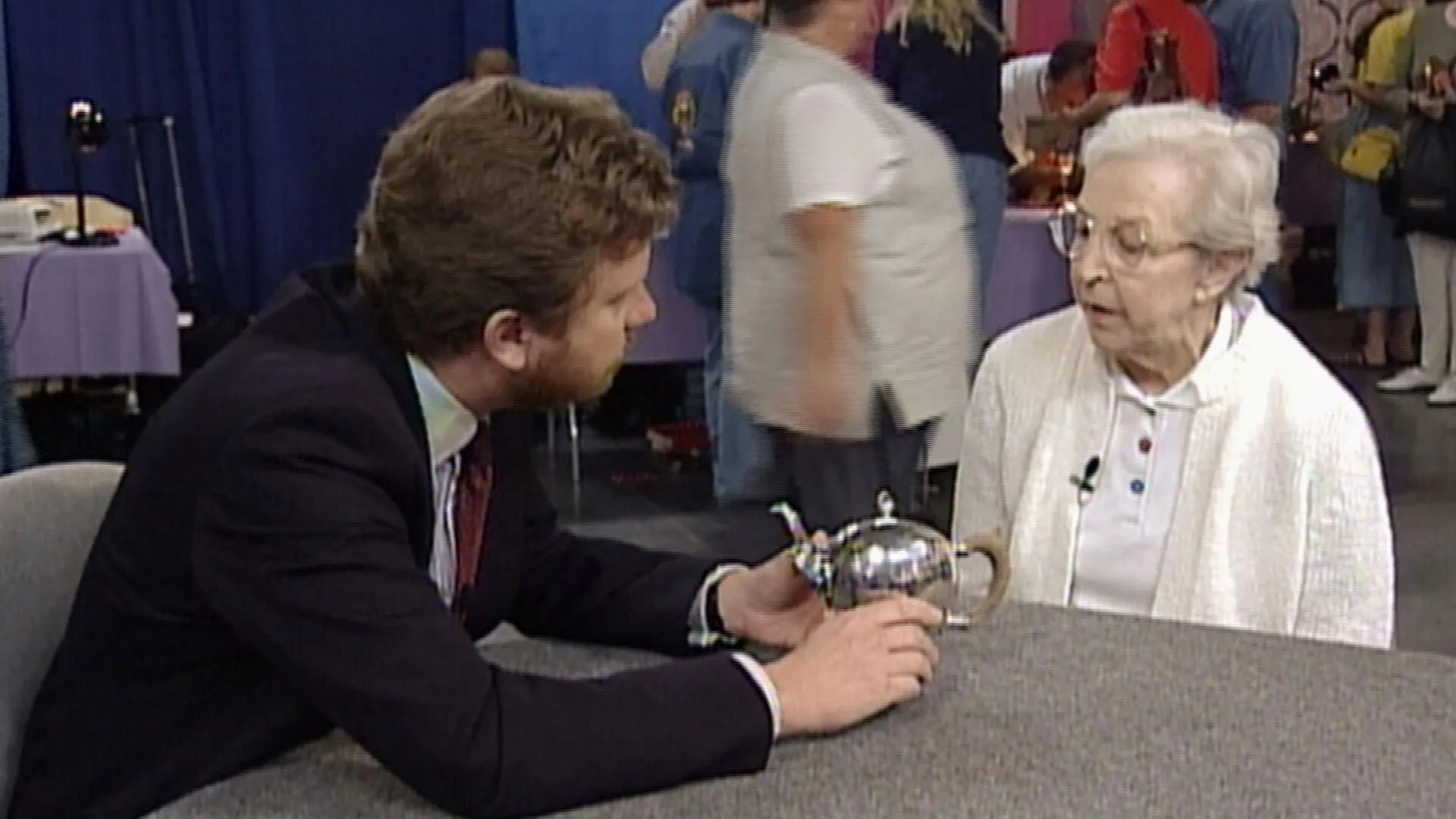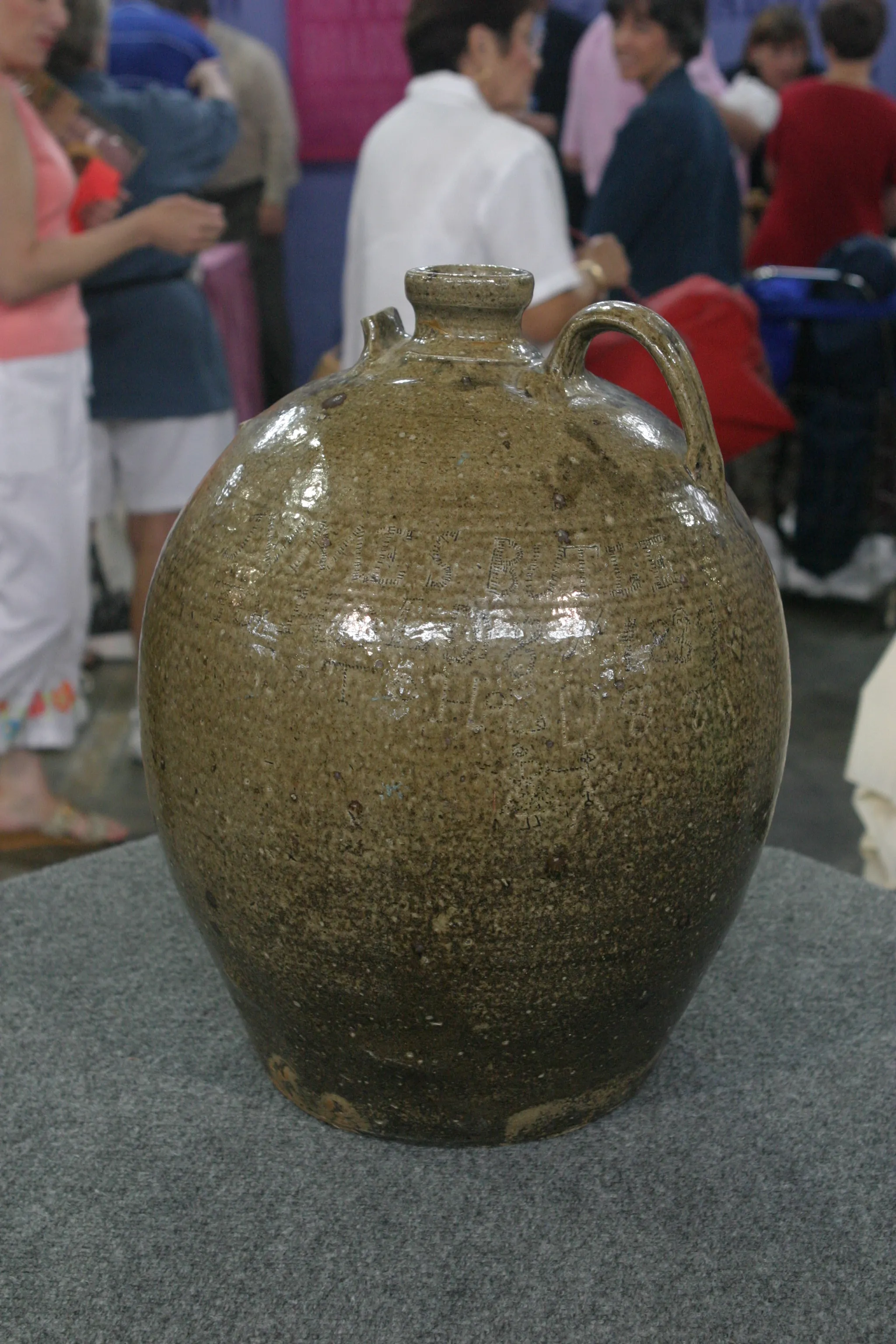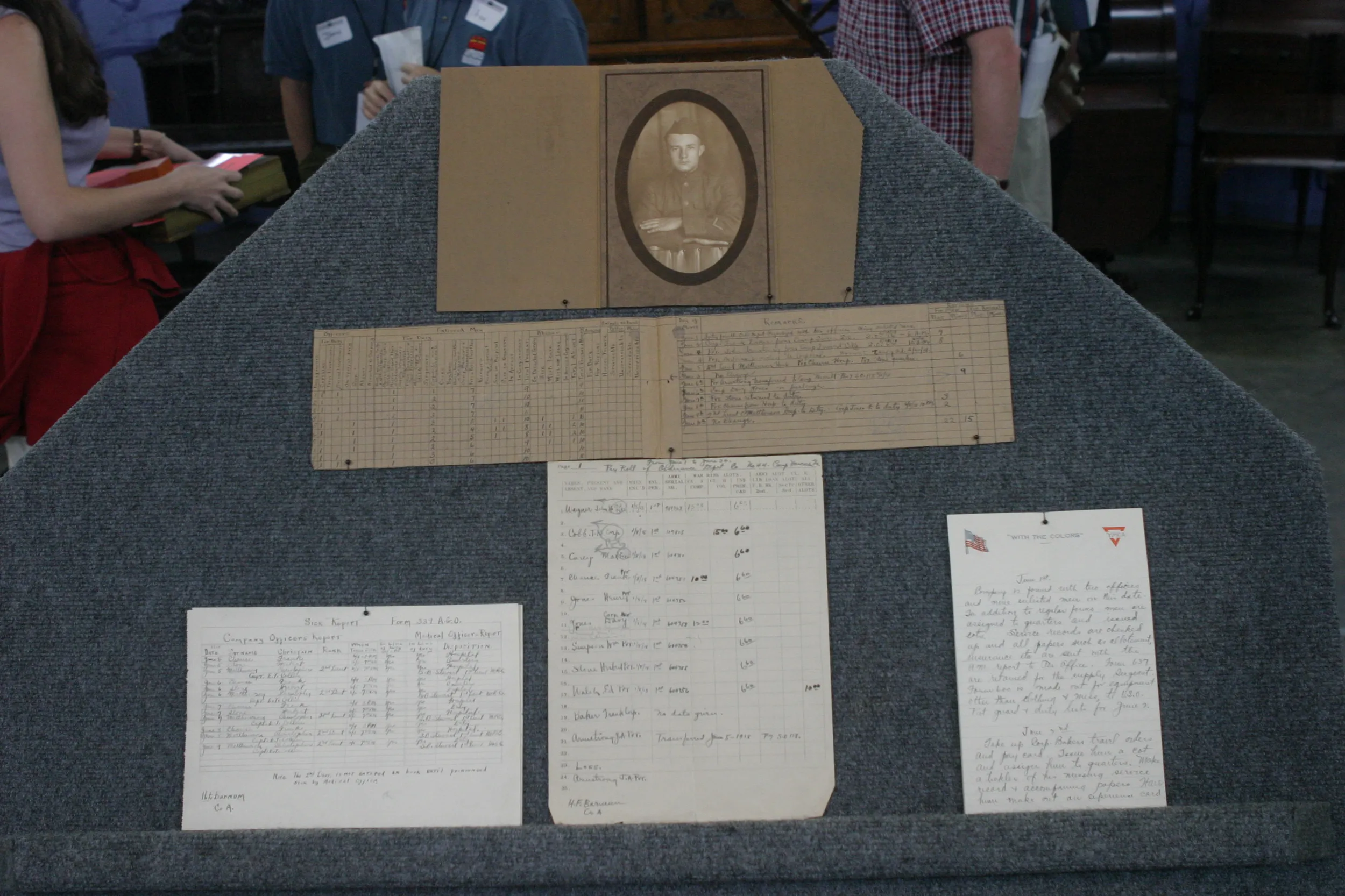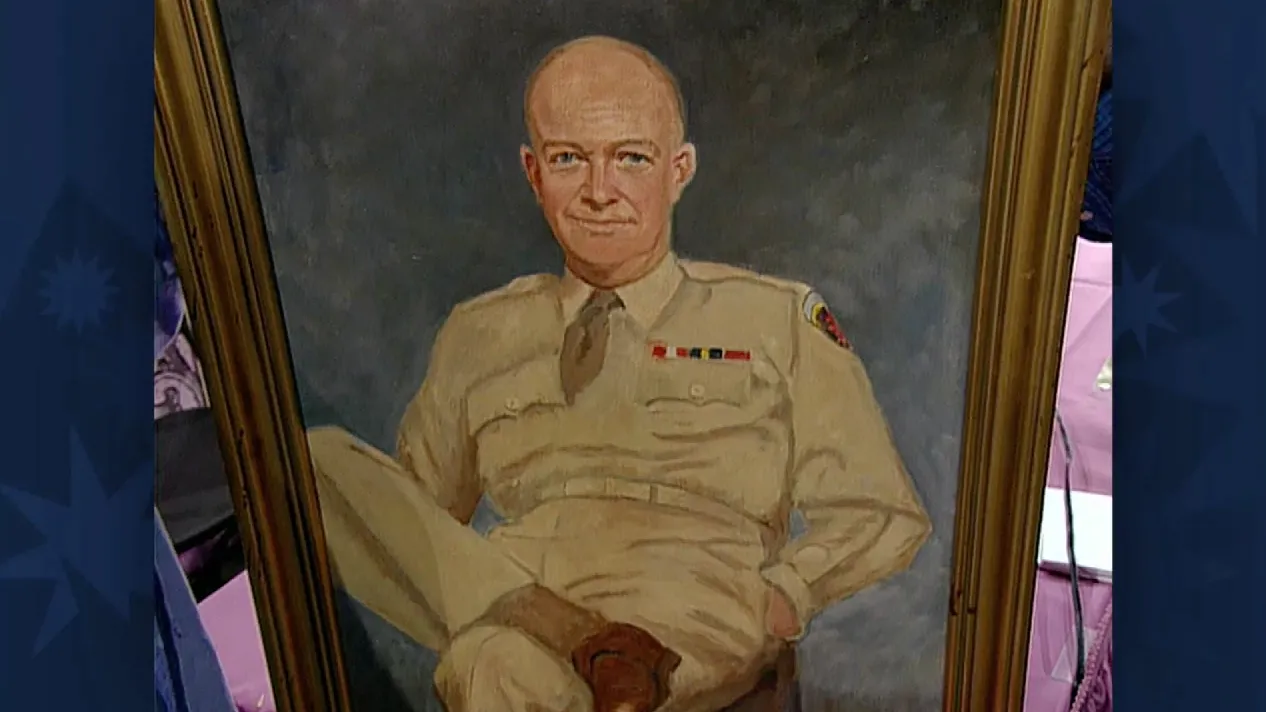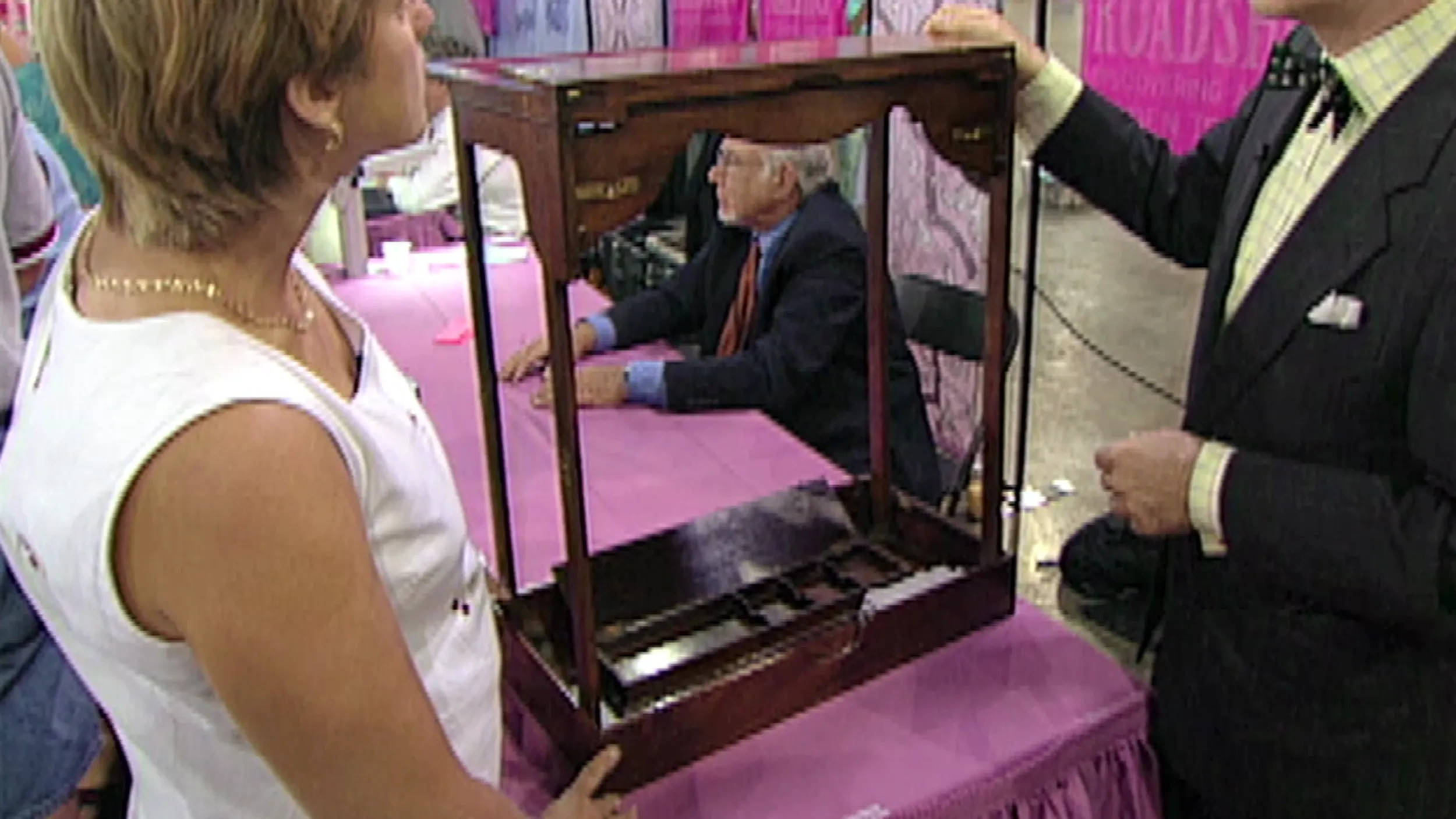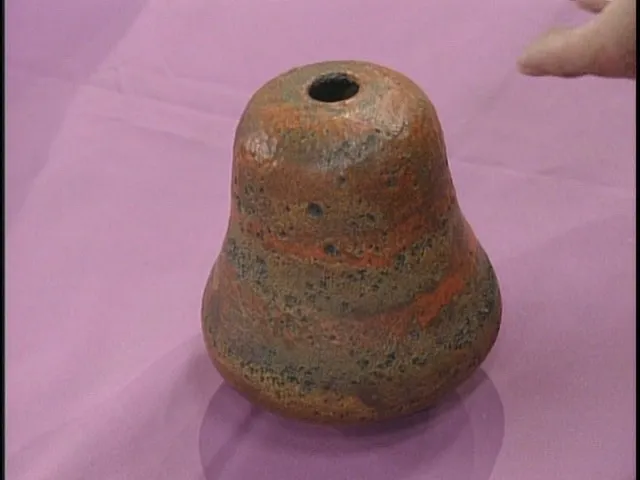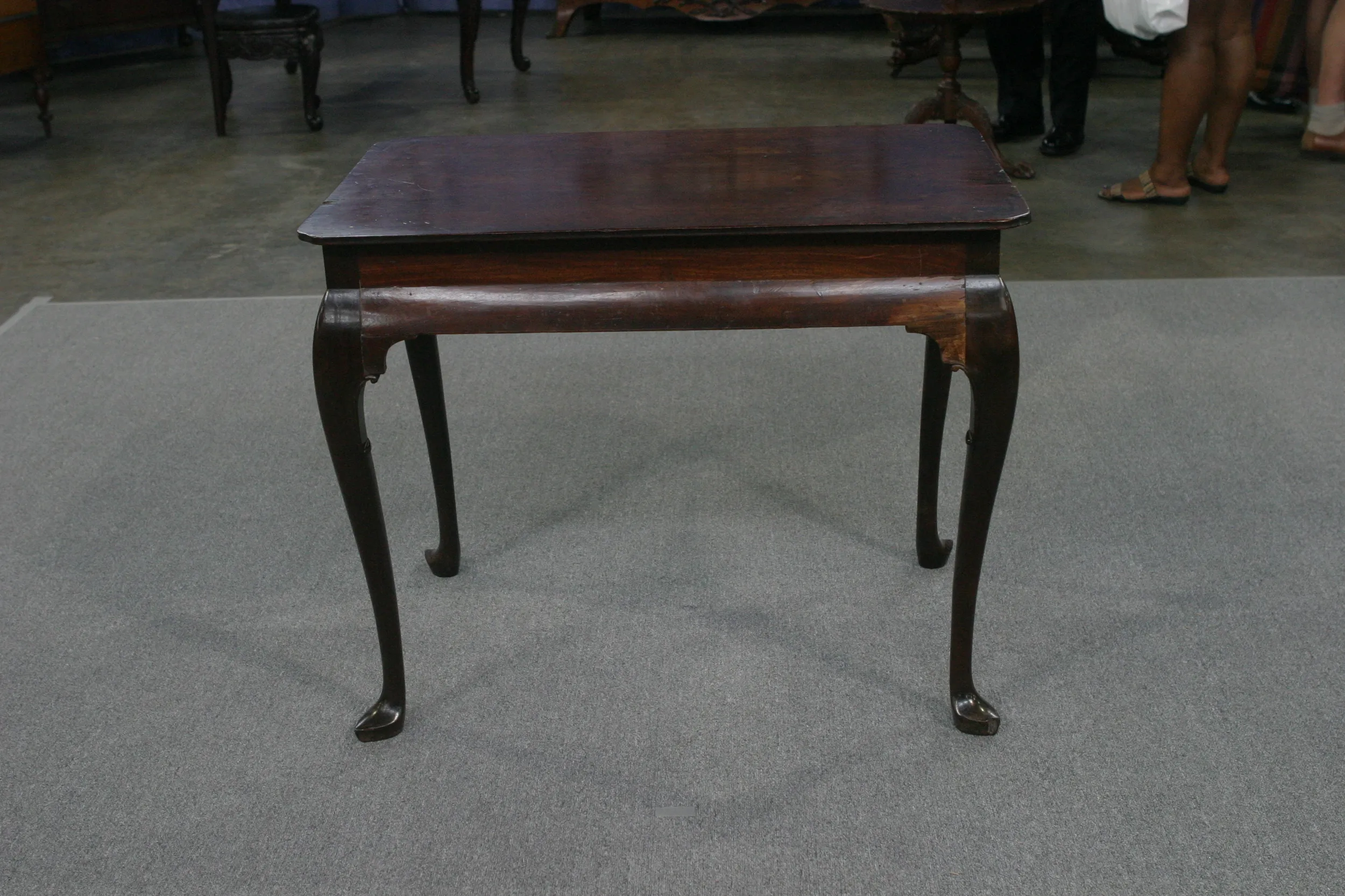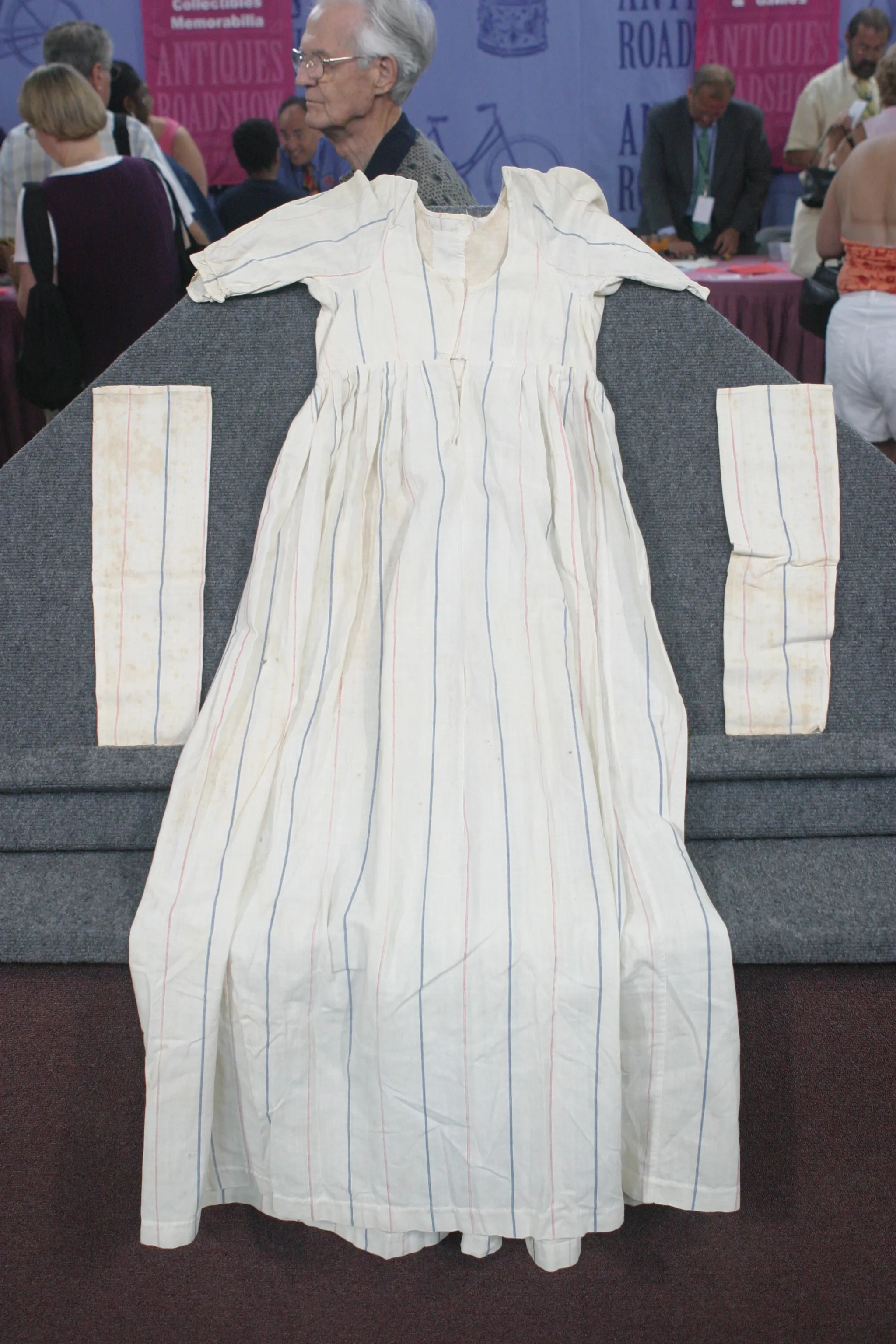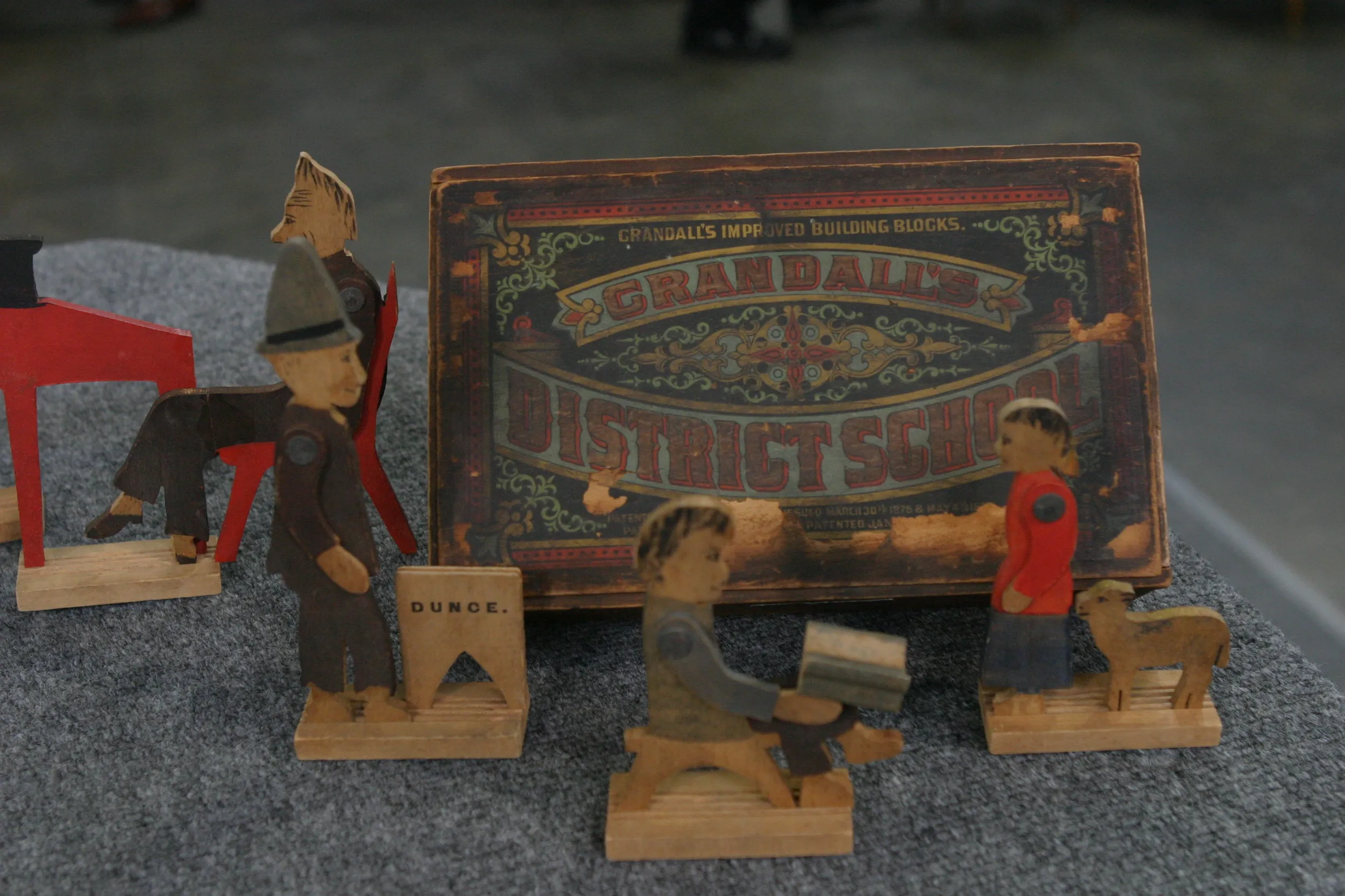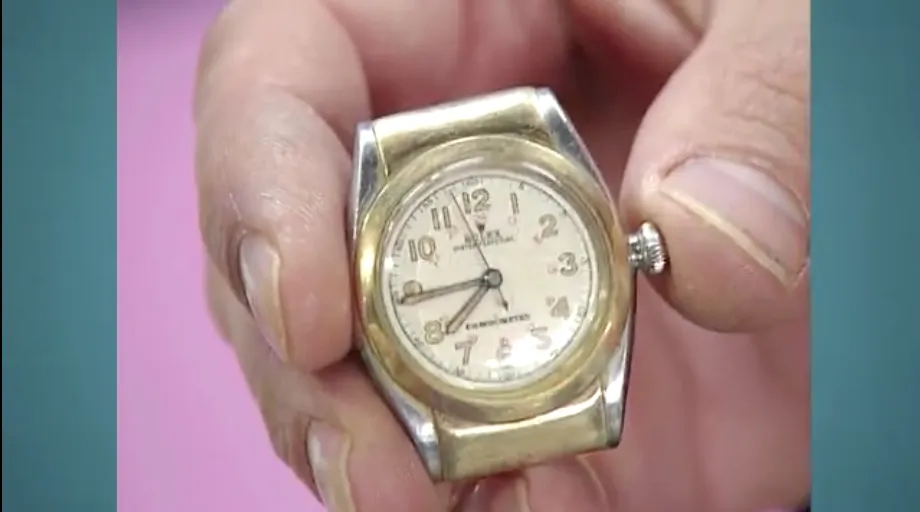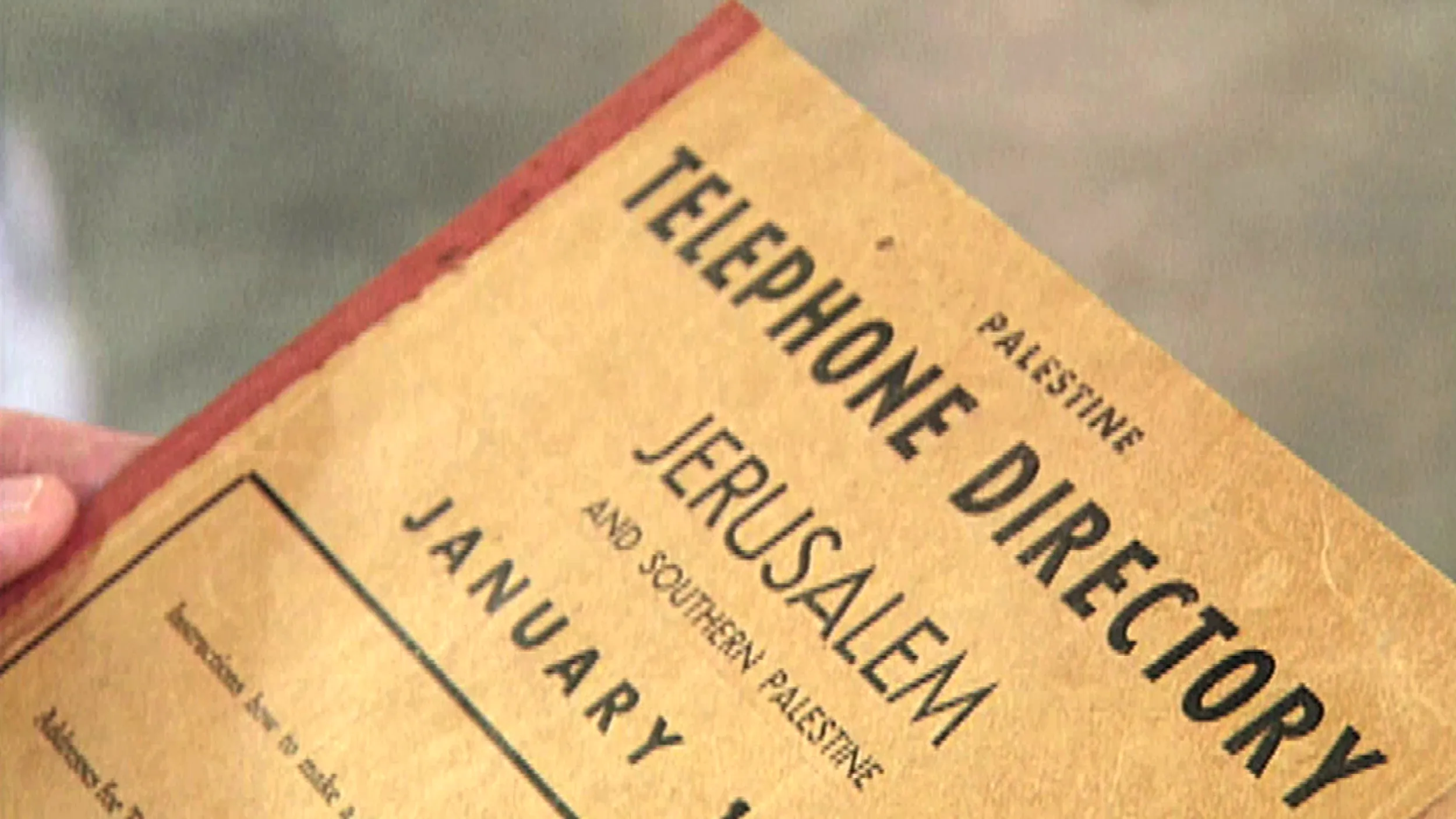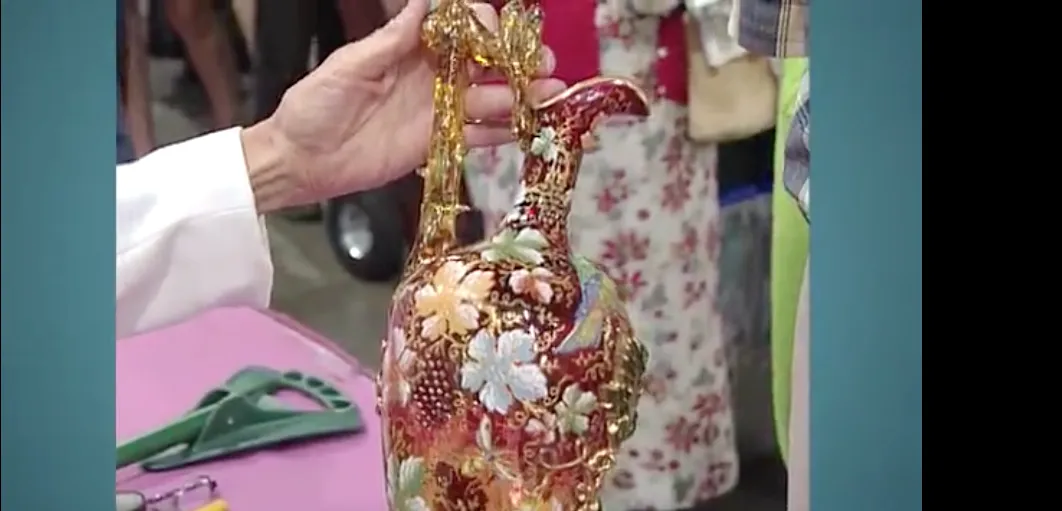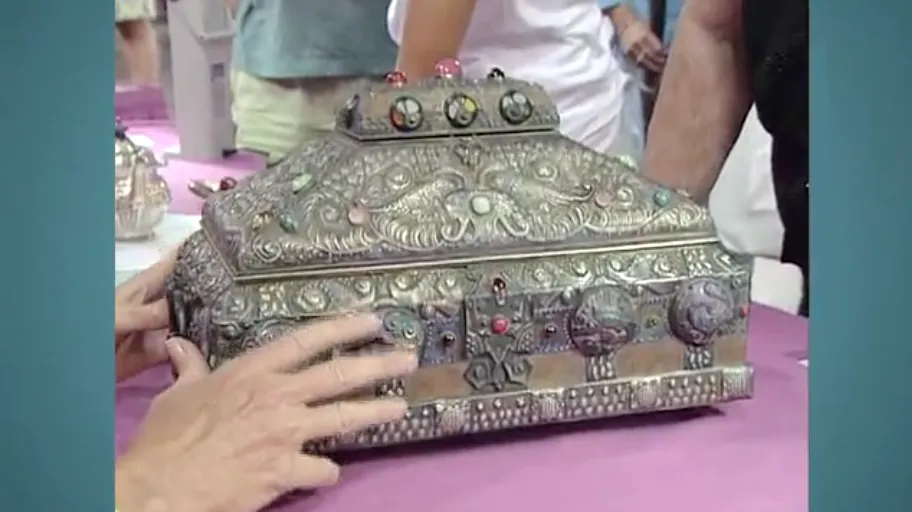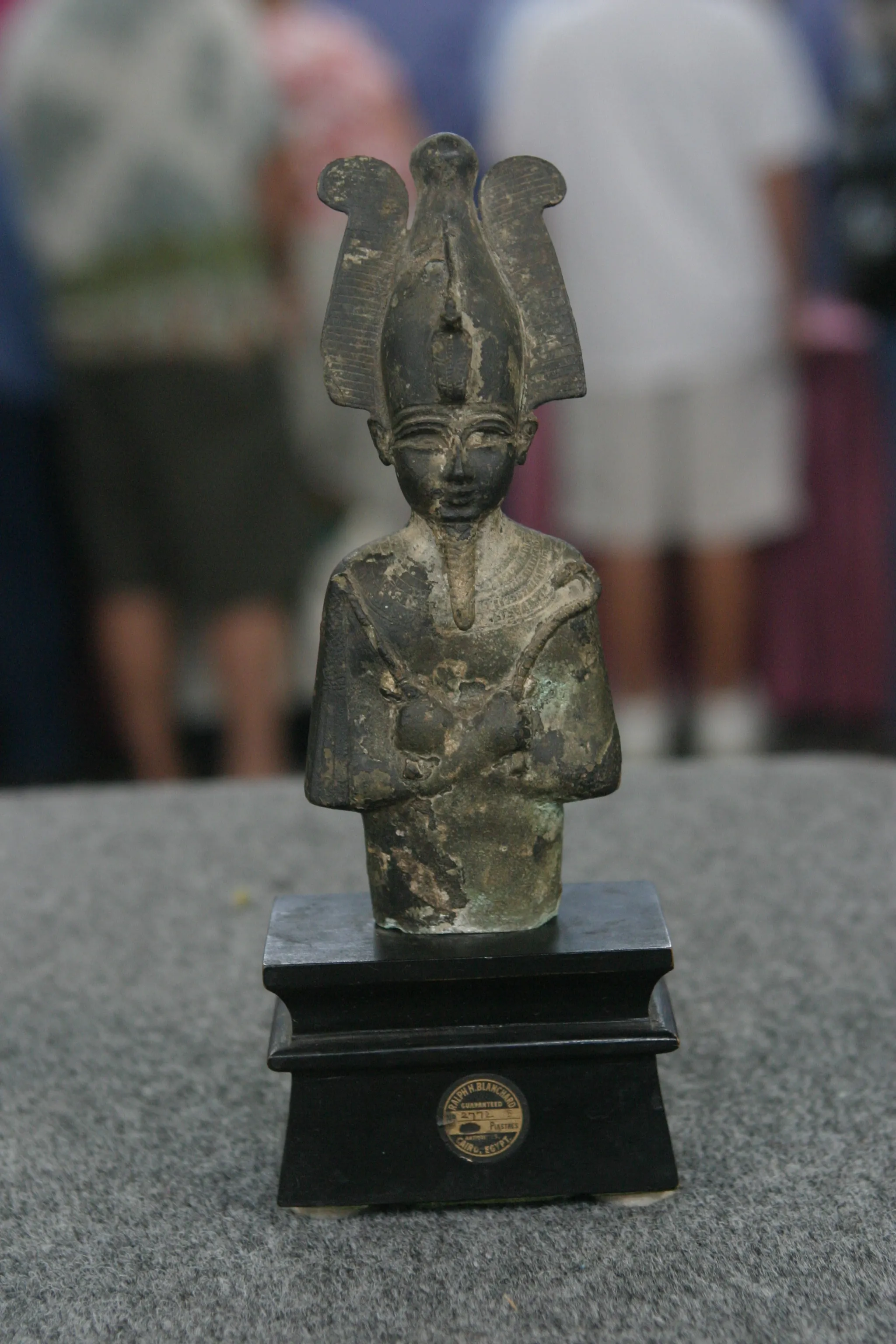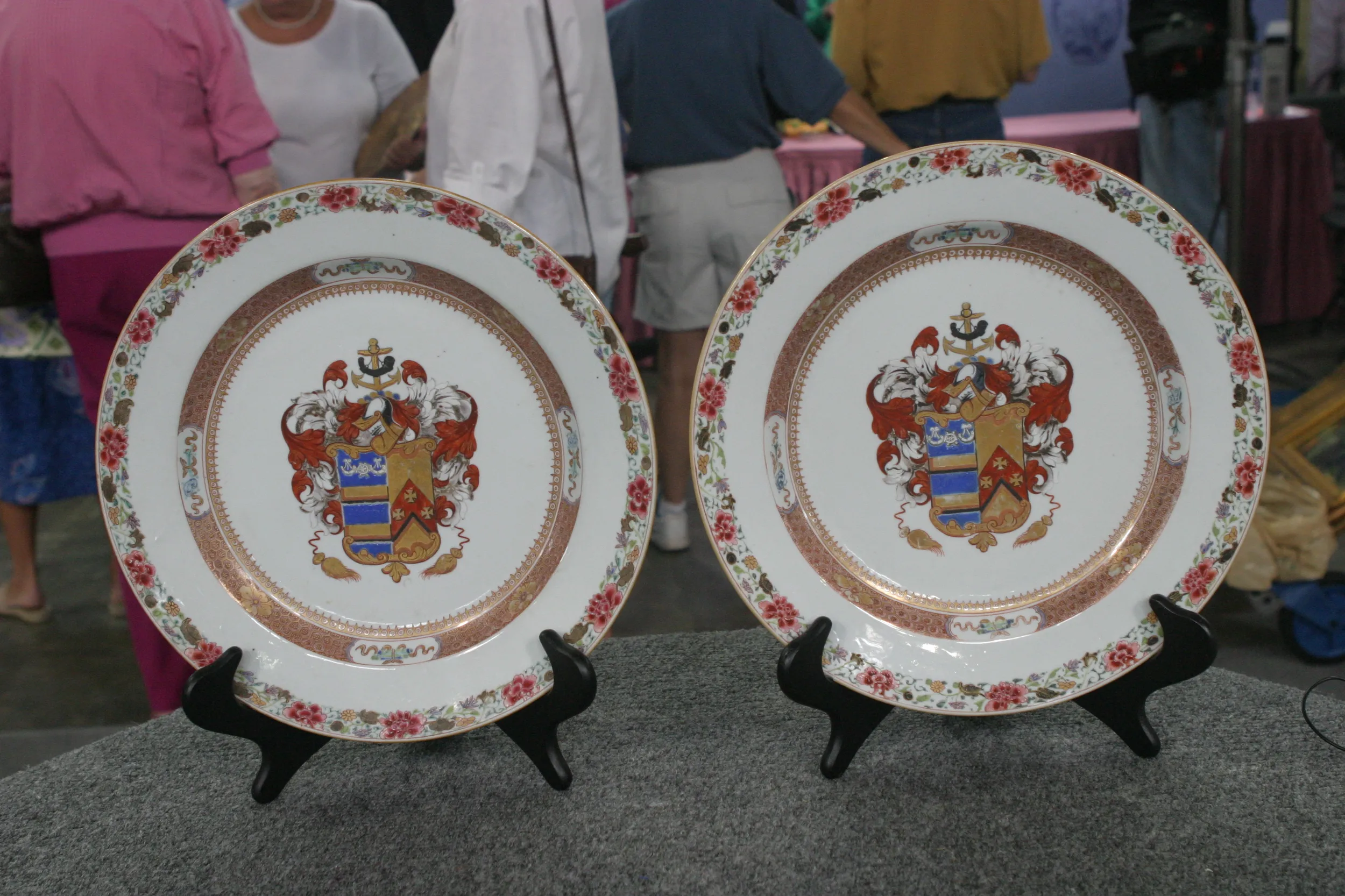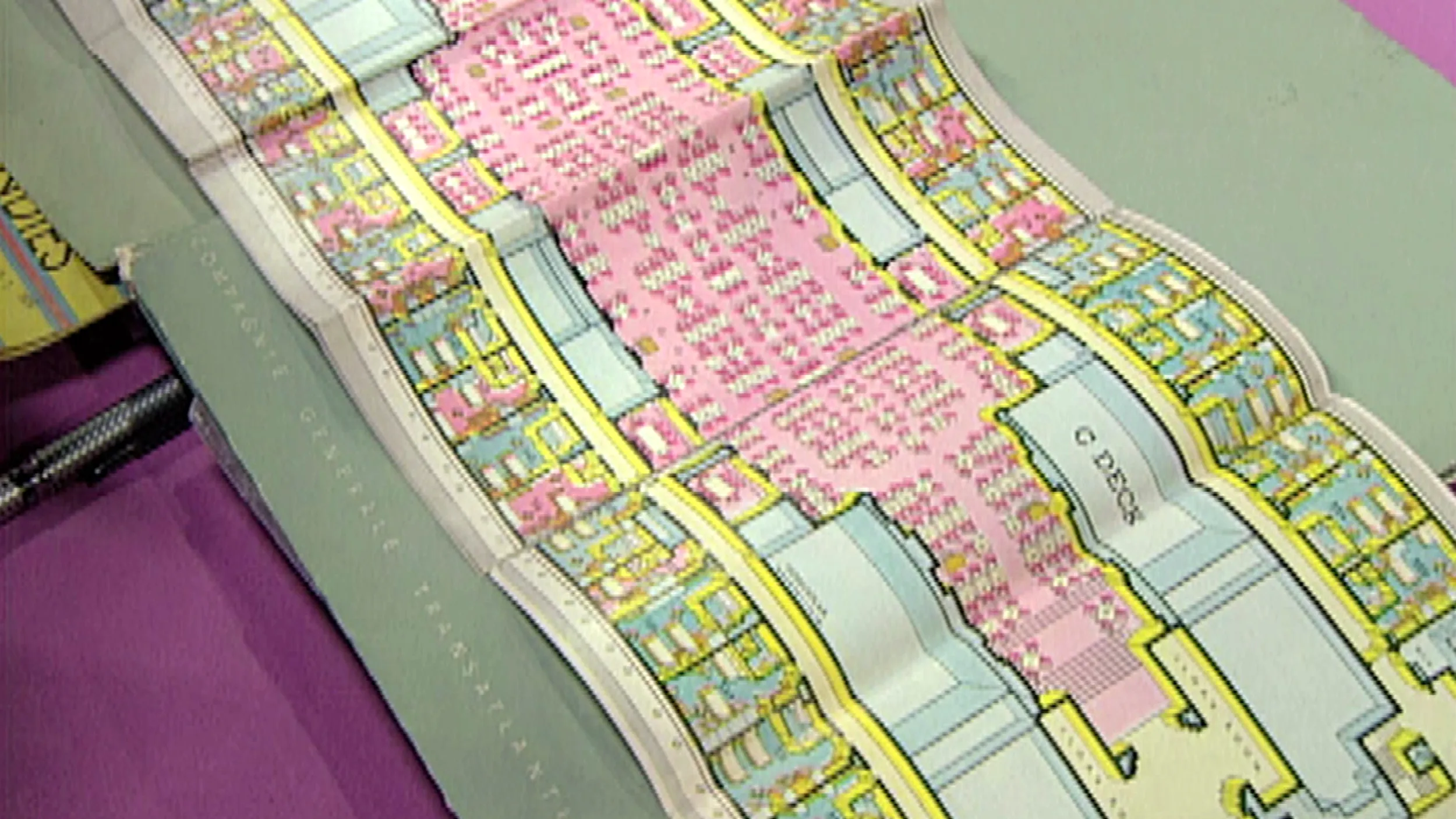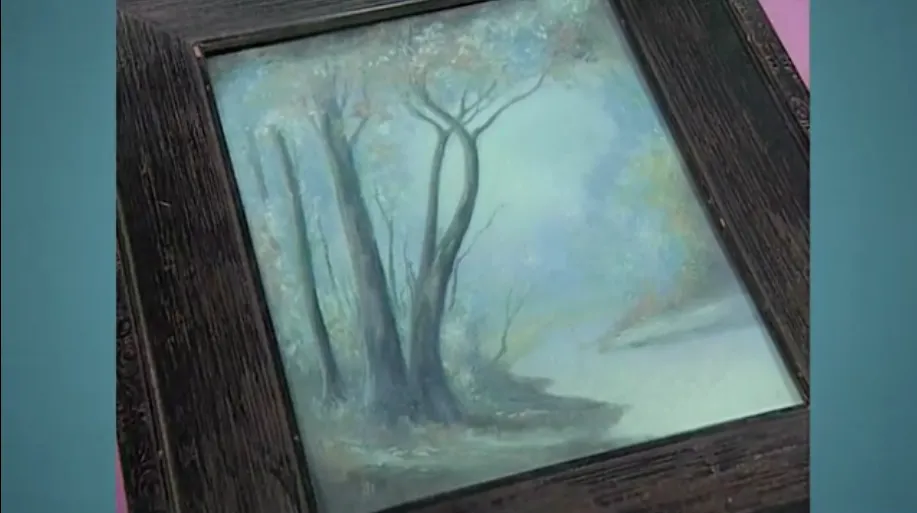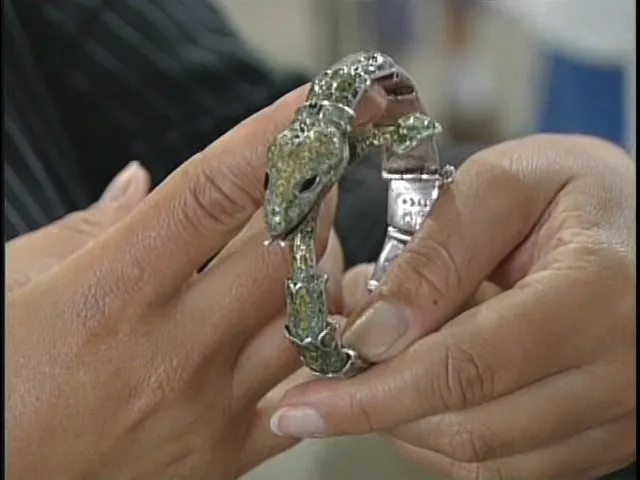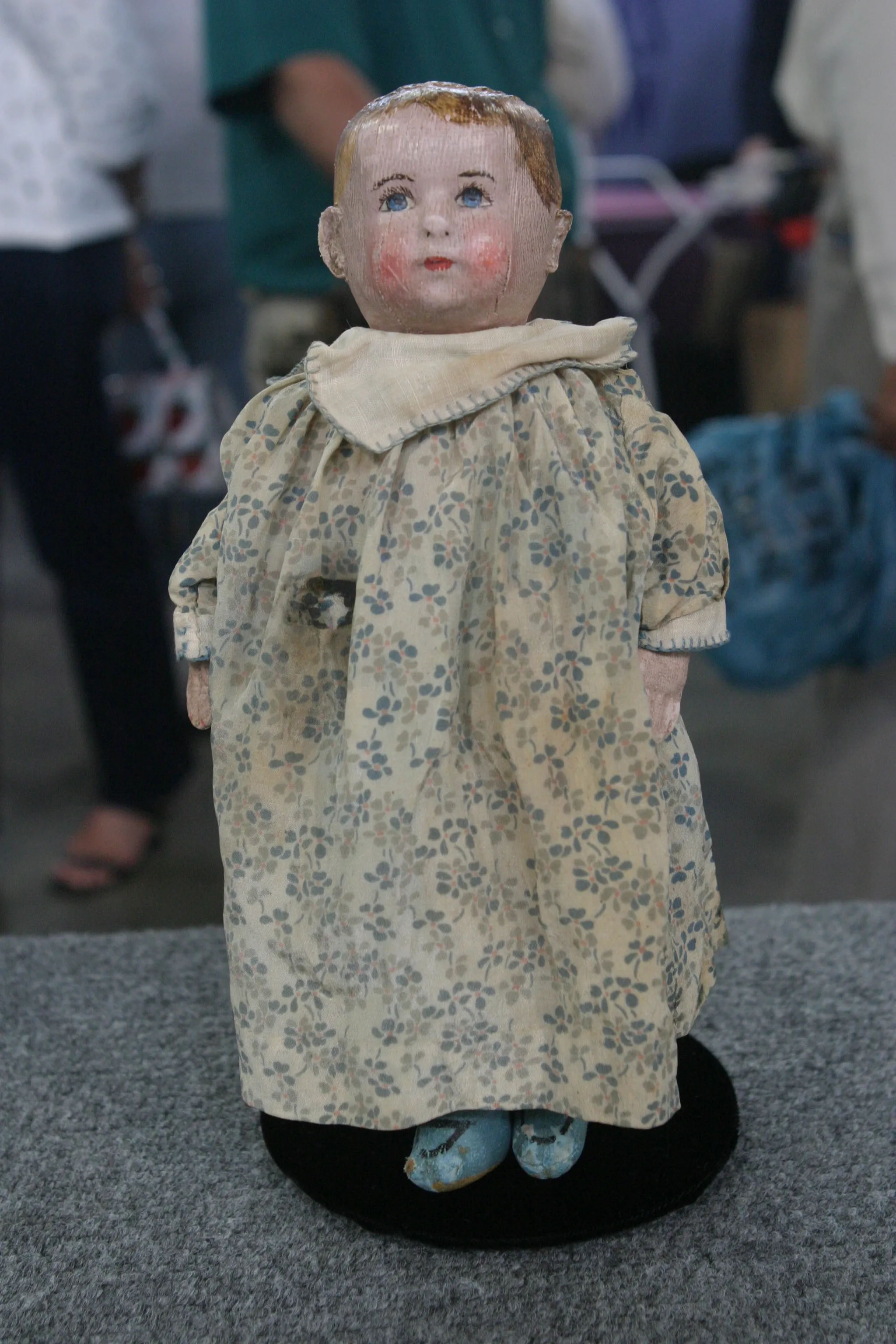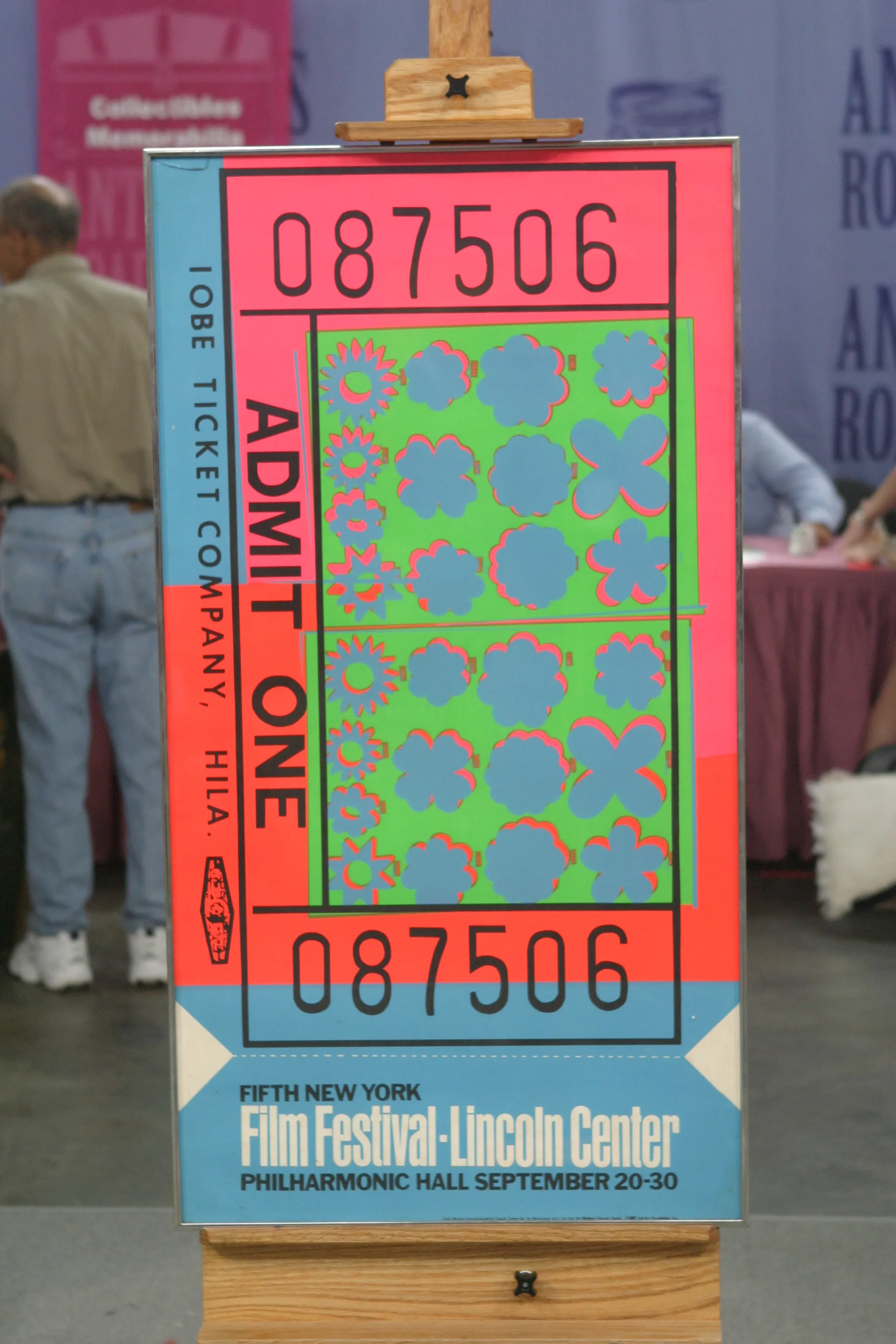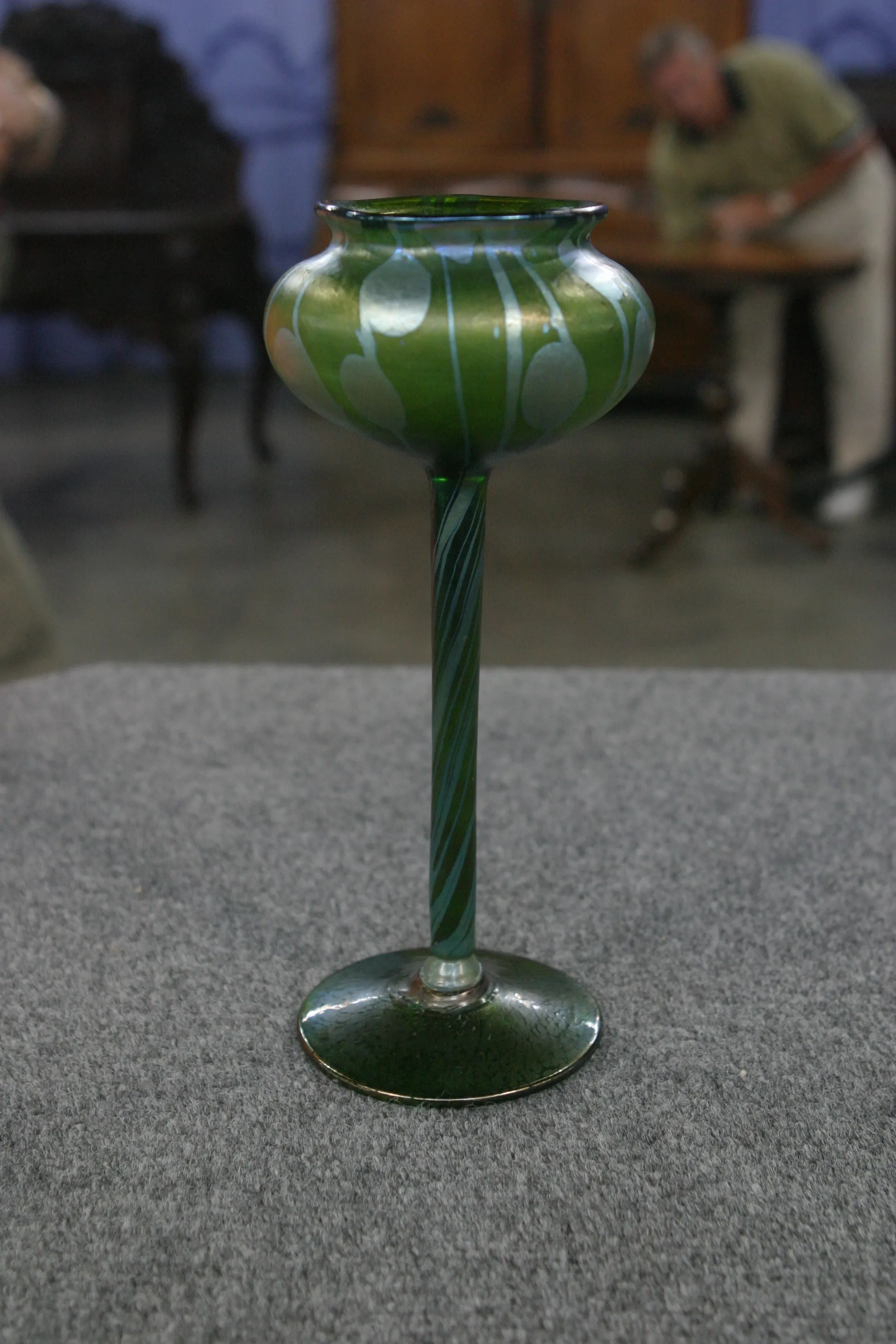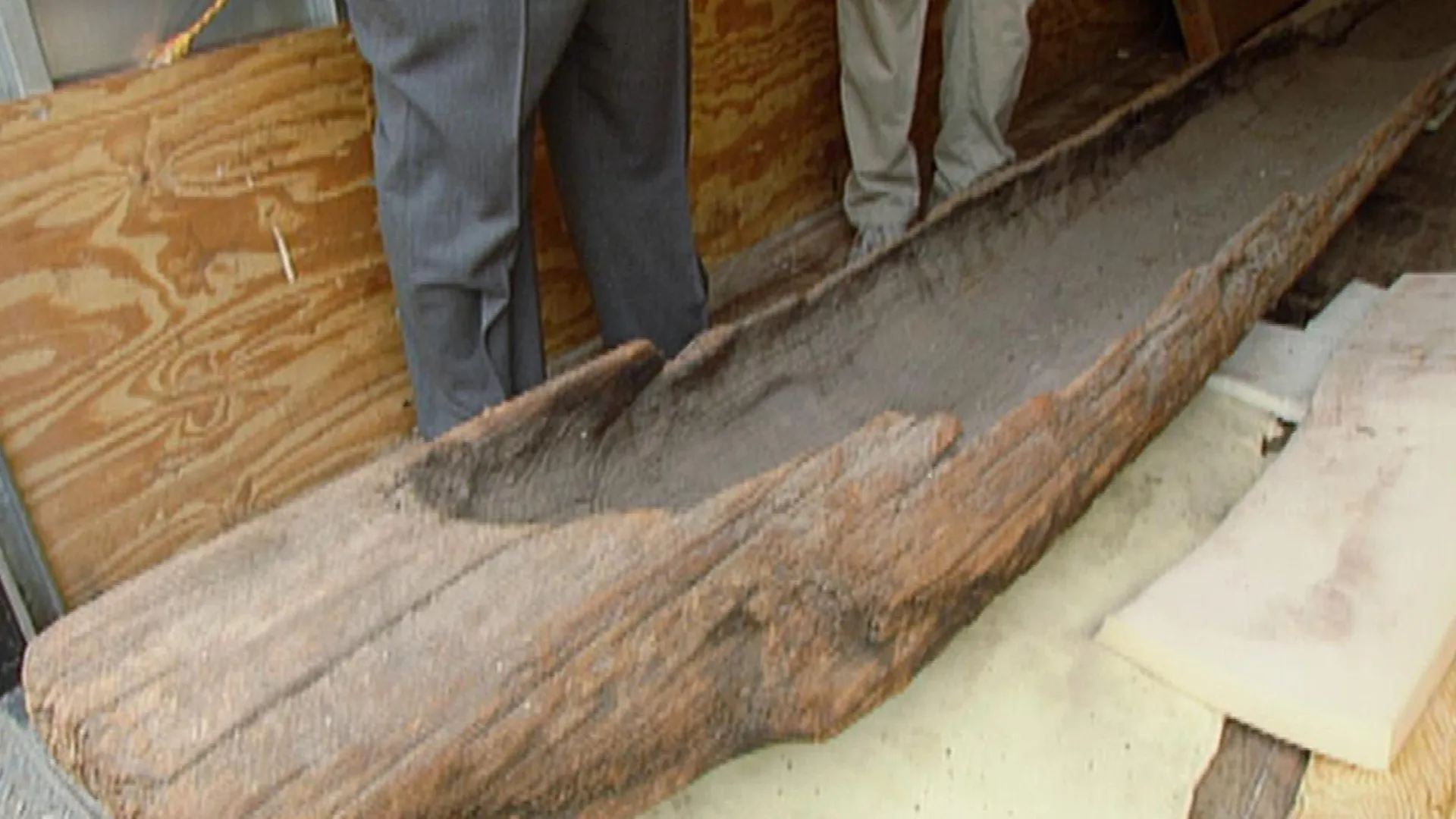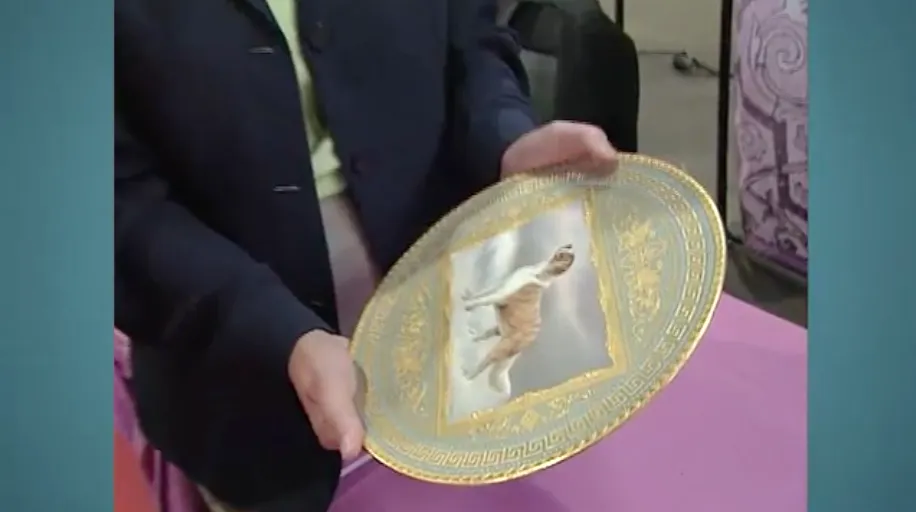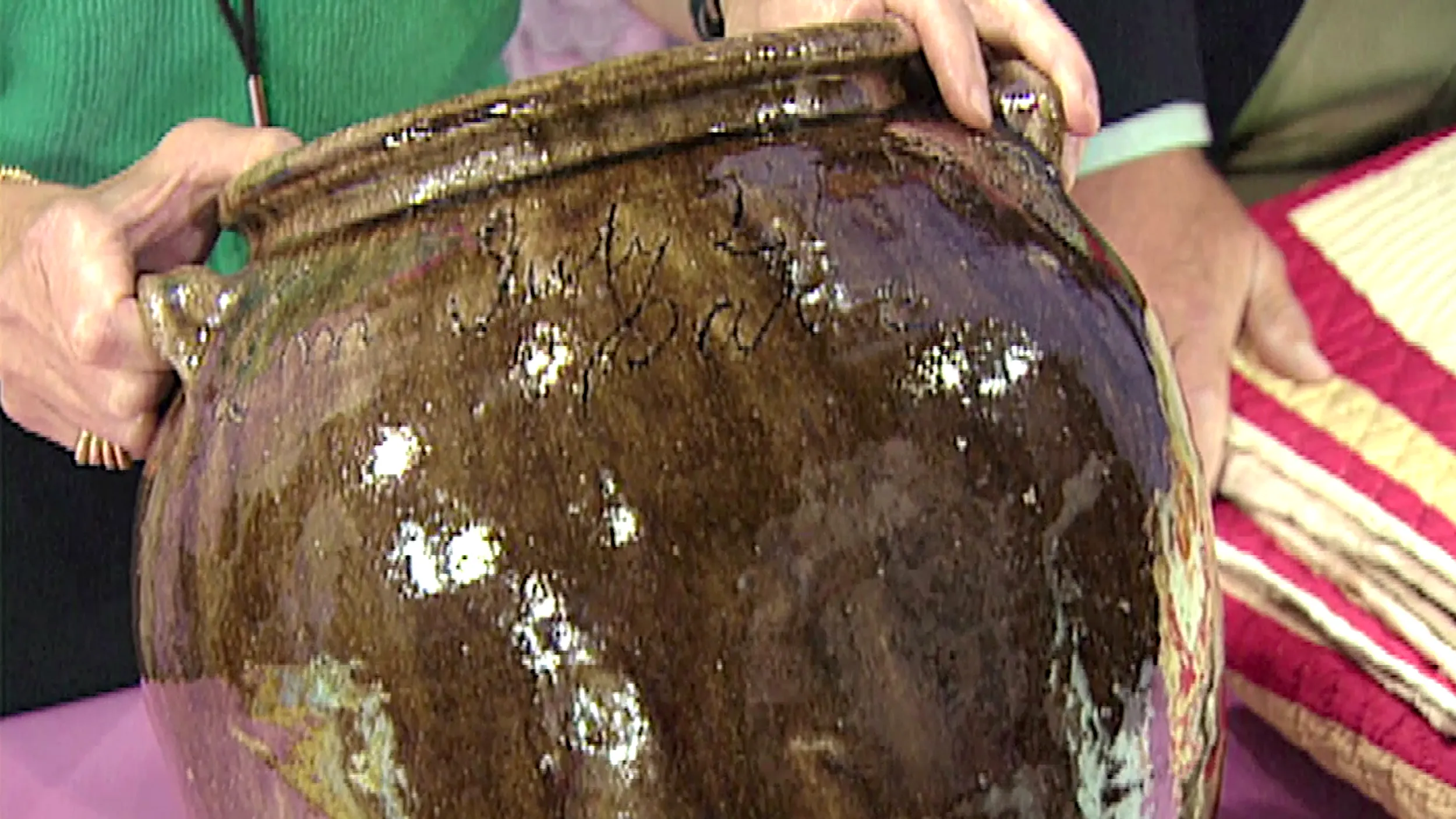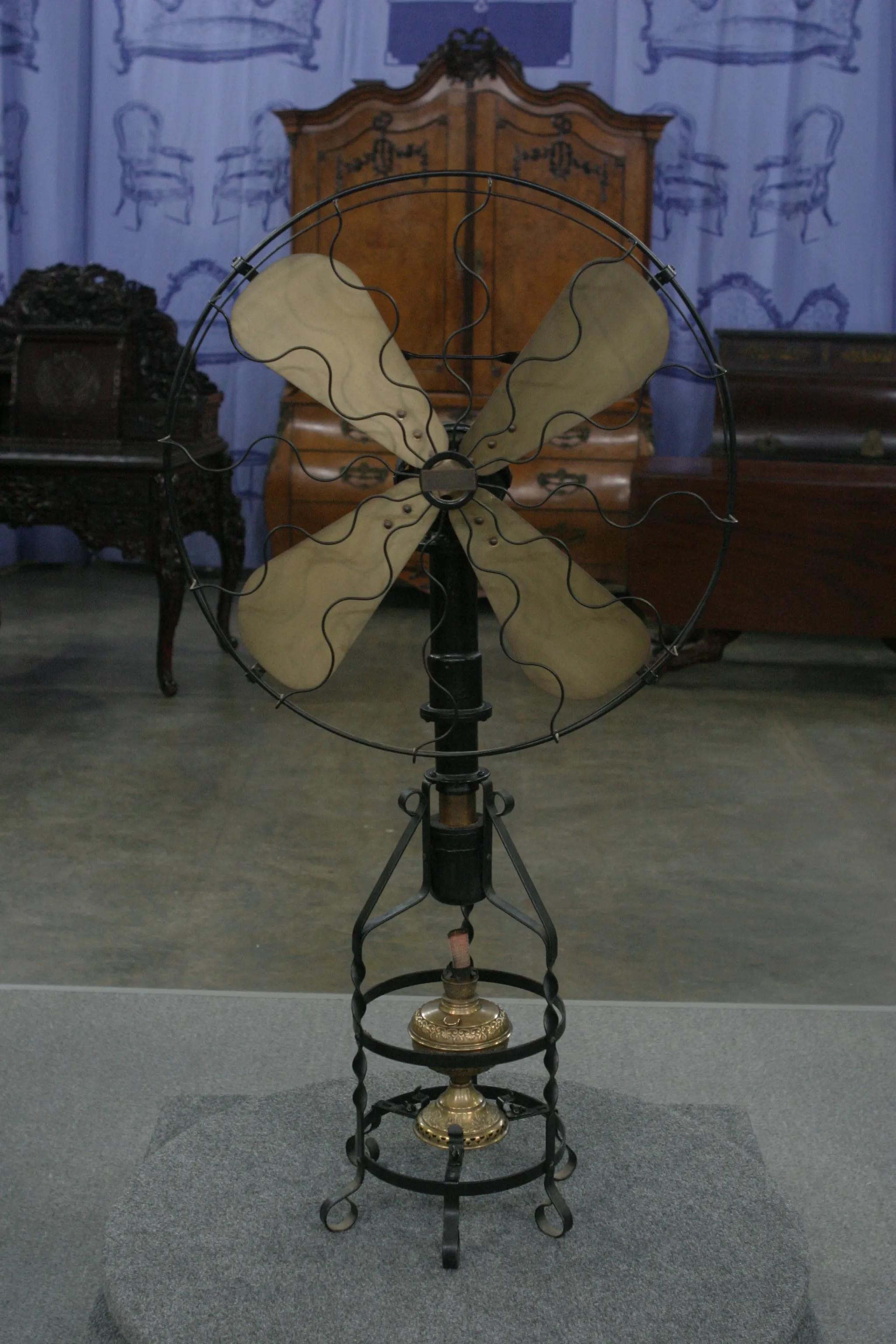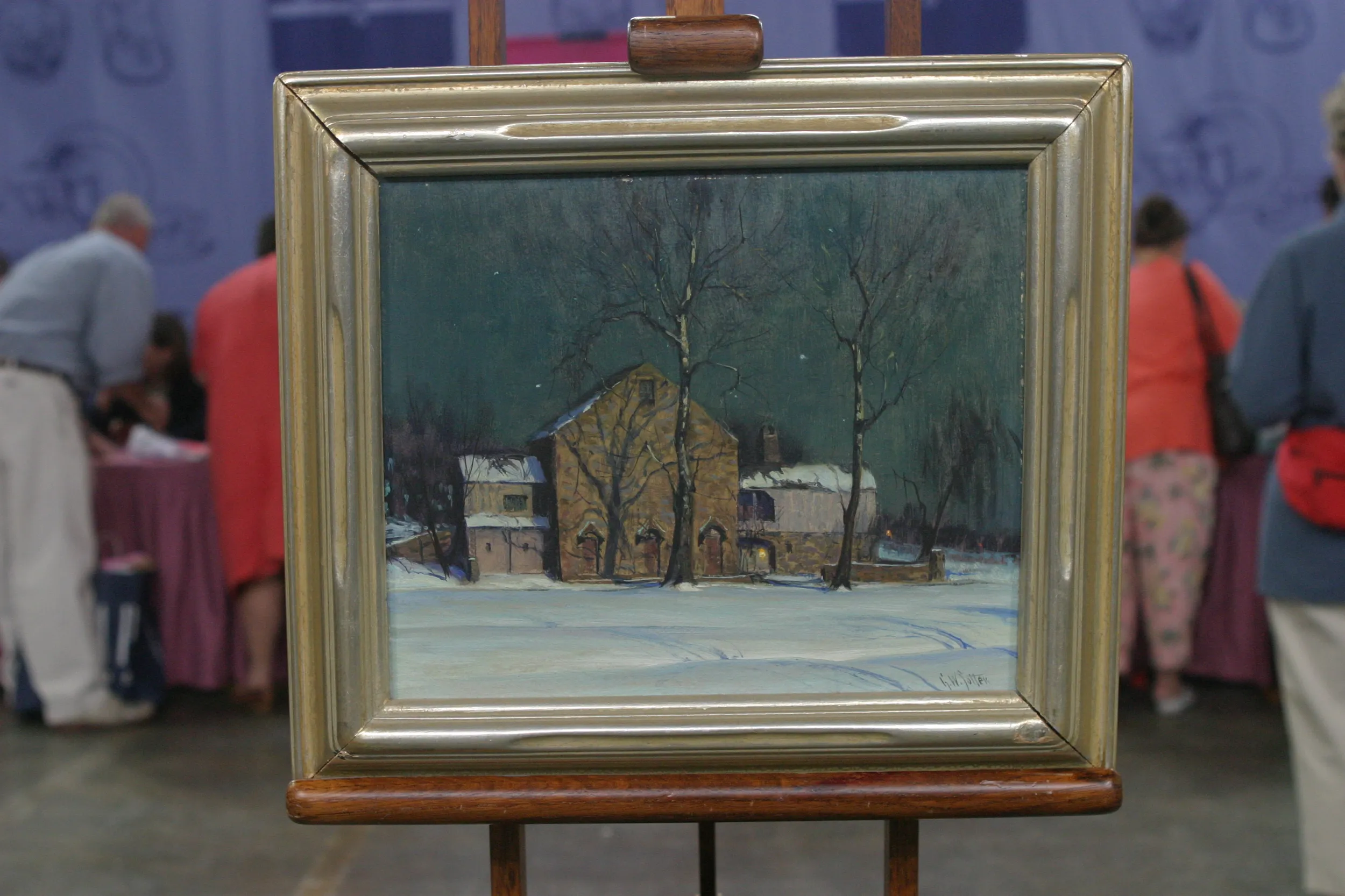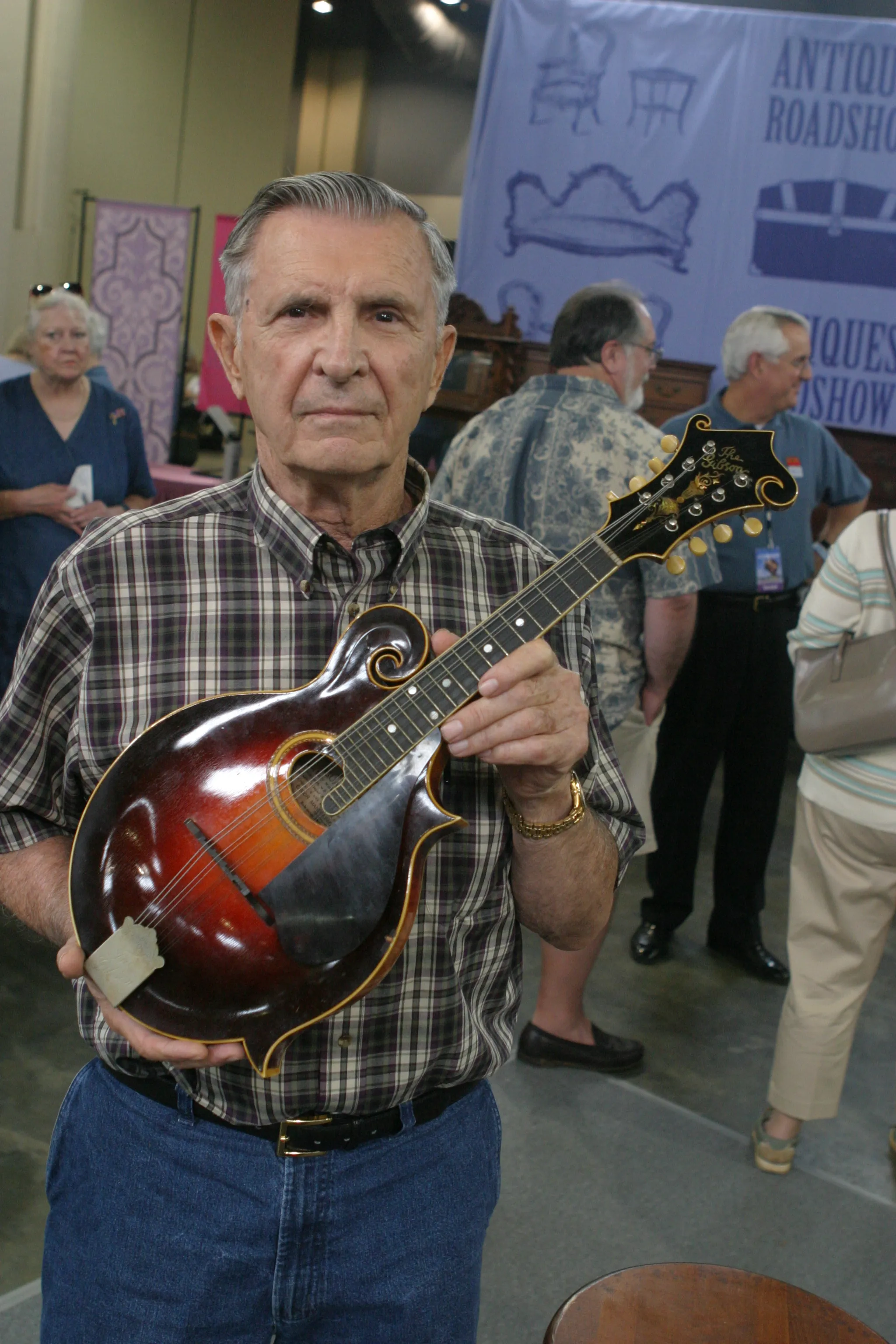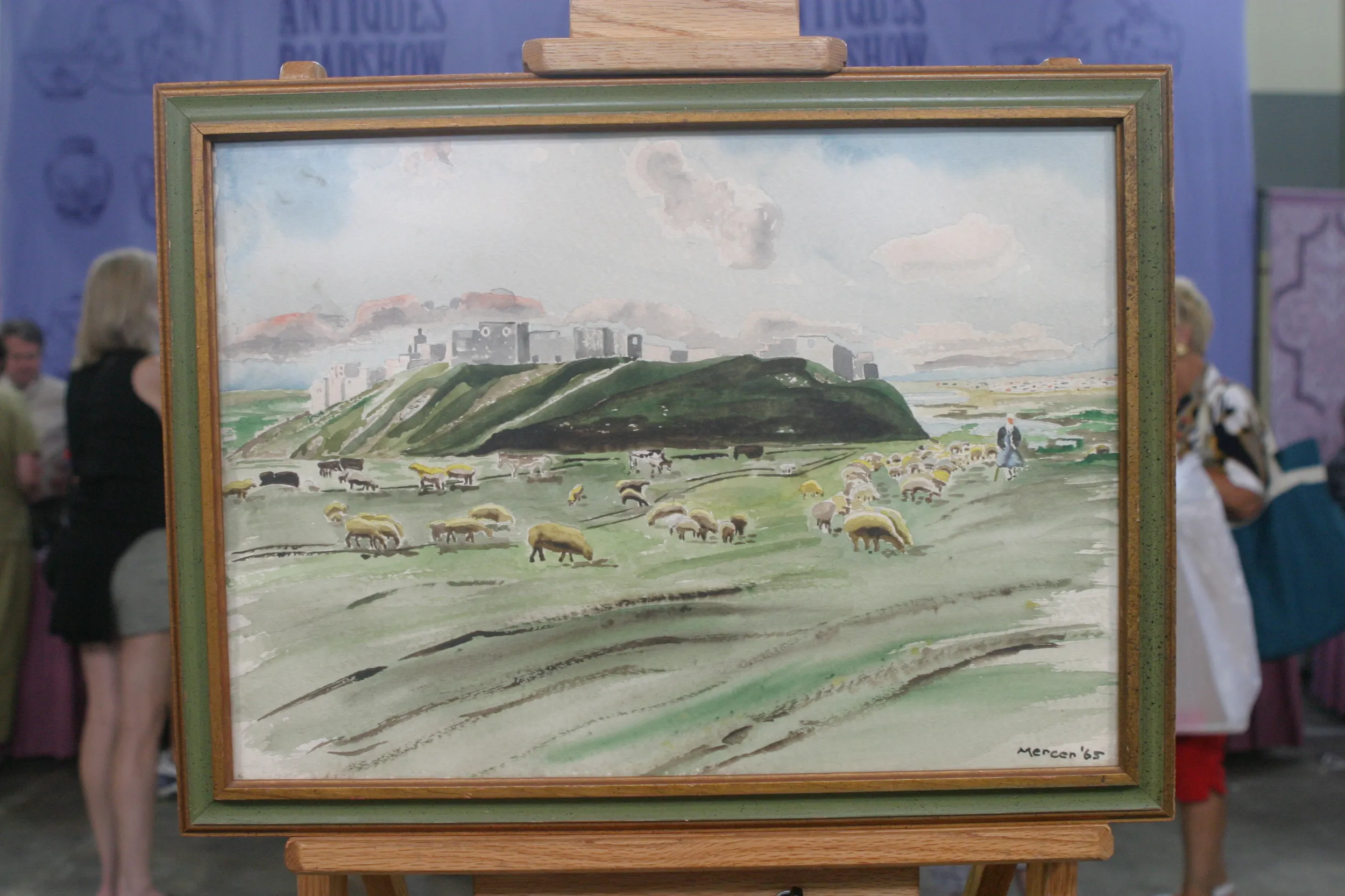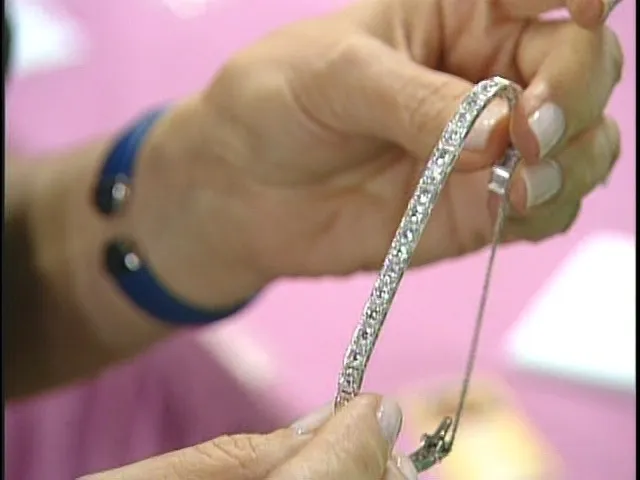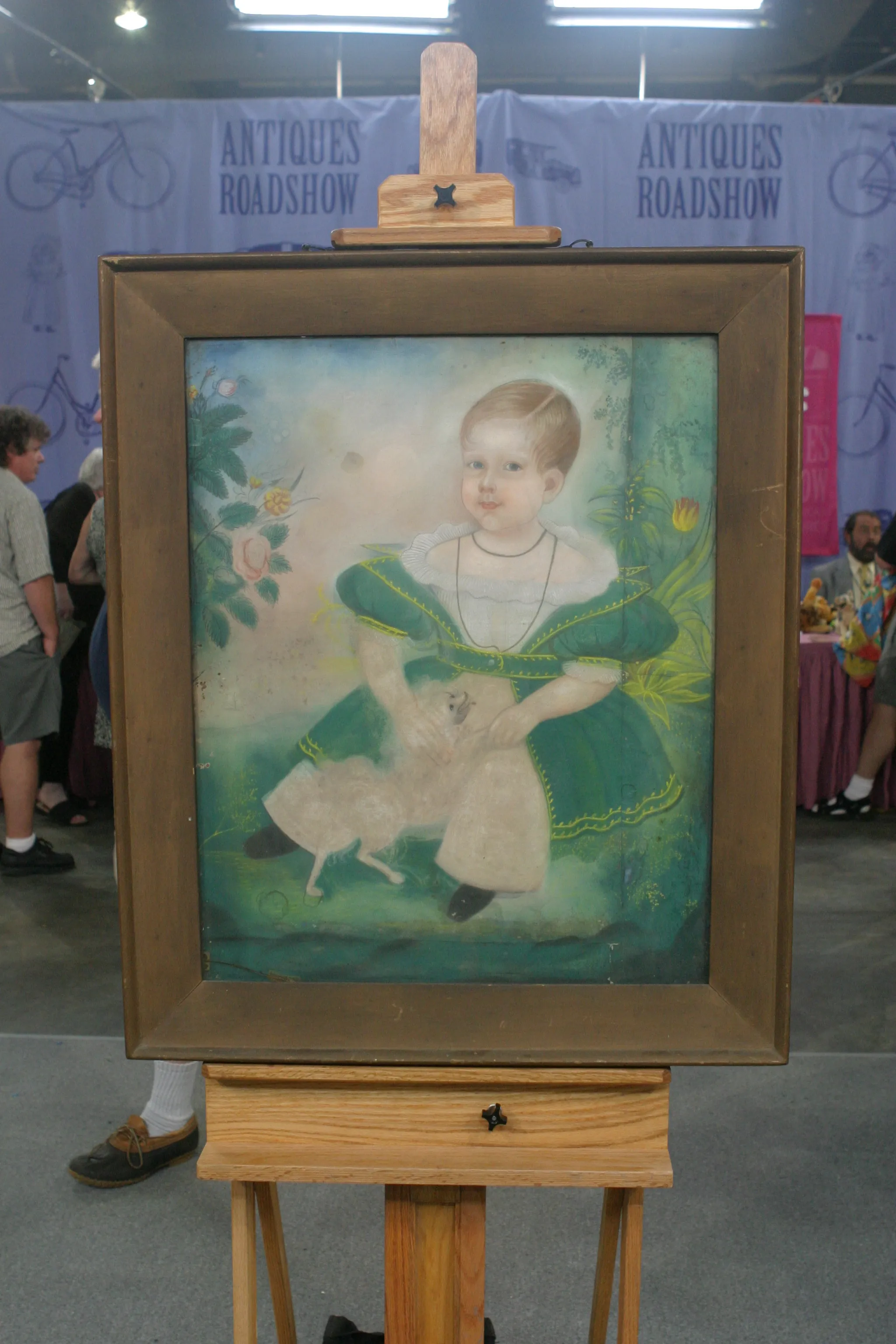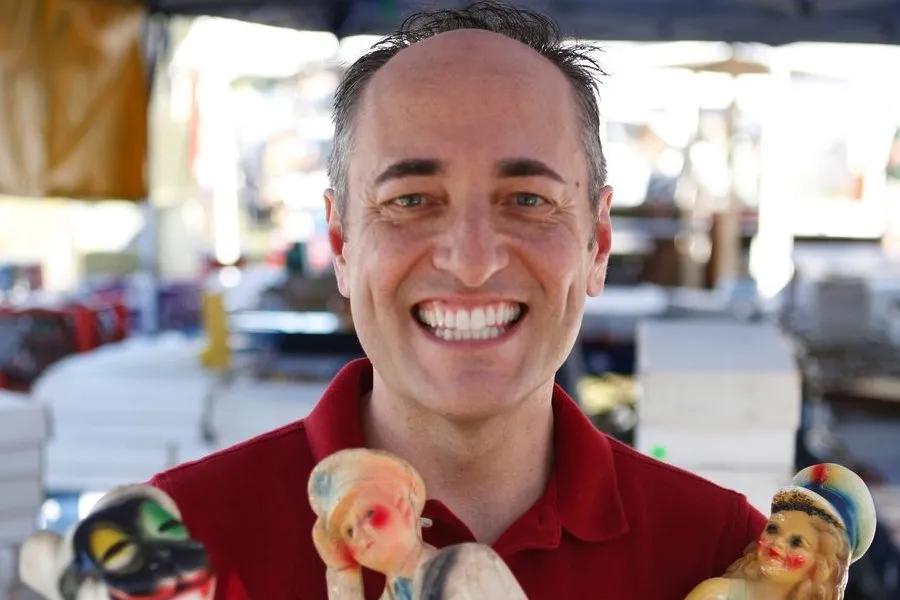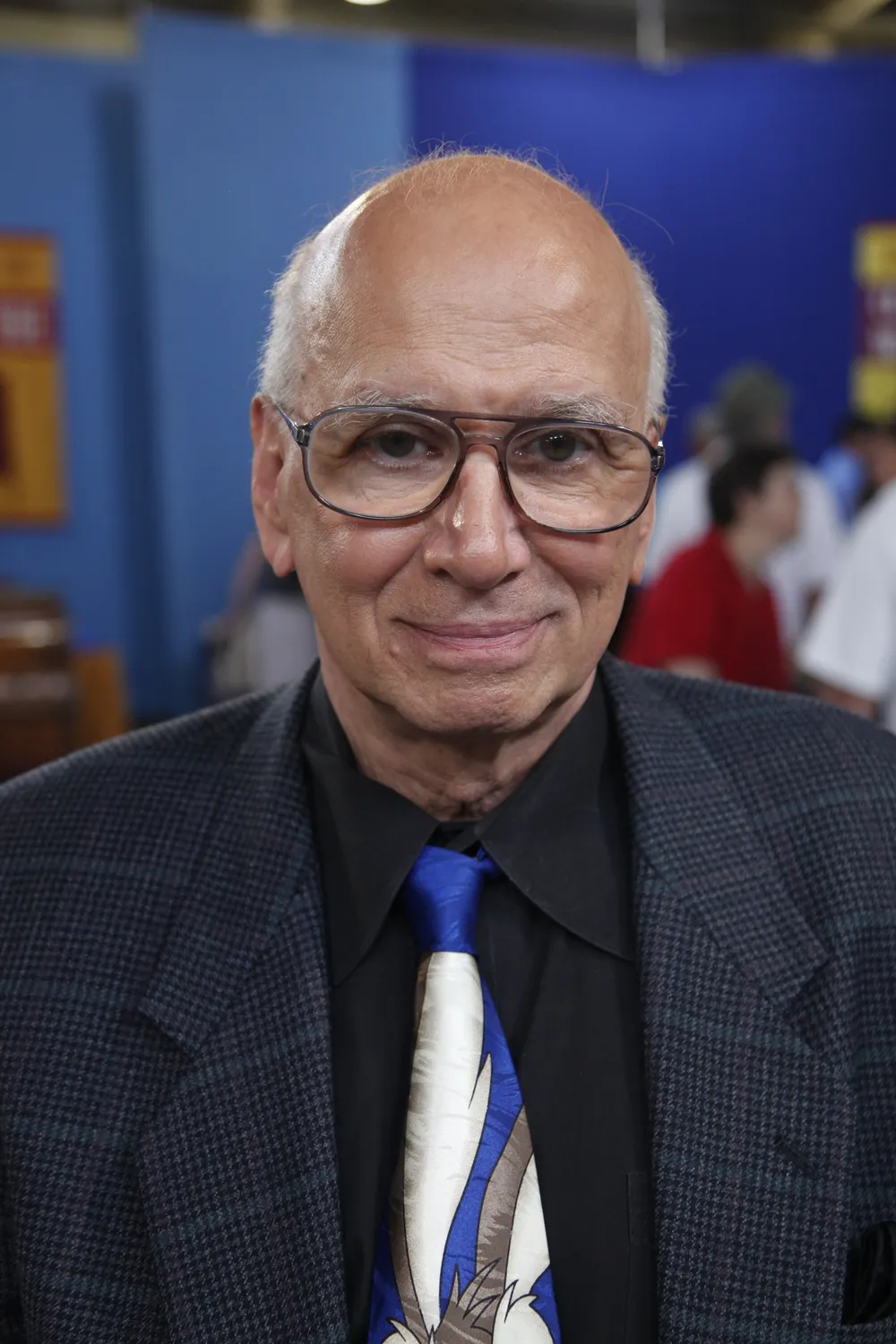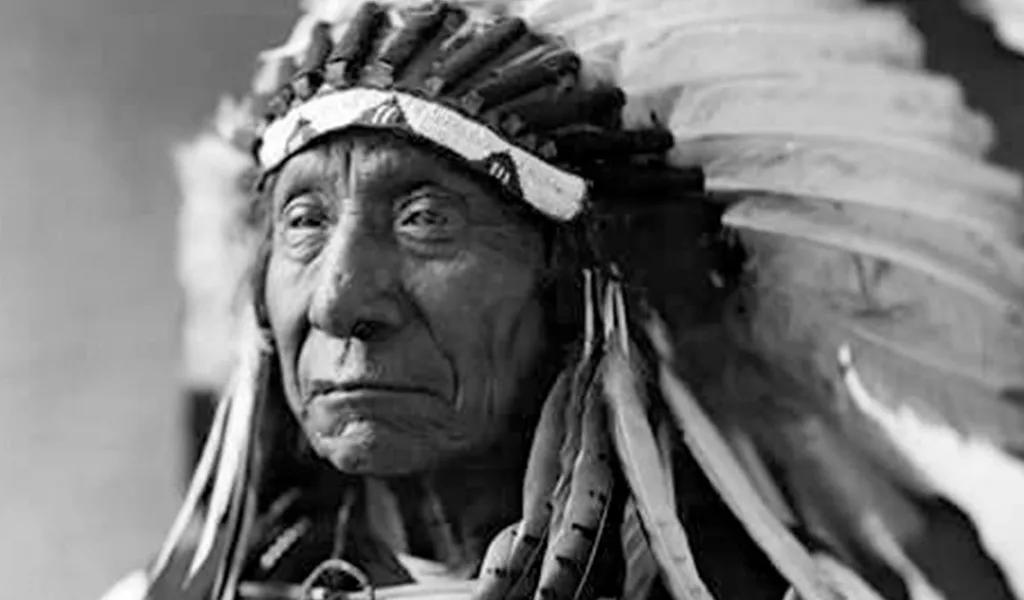APPRAISER: This is one of the ugliest frames I have ever seen.
GUEST: I know. (laugh)
GUEST: Won't be sitting around the house much longer. (laughing)
APPRAISER: So it's cooling and it's heating at the same time.
HOST: When ANTIQUES ROADSHOW visited Savannah in 2003, Southern fans lined up to show off their most prized possessions.
GUEST: Yep, this is going to be so fun. Isn't that nice? All right.
GUEST: Don't put me on TV like this.
HOST: Have the values of these and other treasures gone up, down, or stayed the same?
GUEST: Oh, my goodness.
HOST: Let's find out, starting with this rare local jug.
GUEST: It belonged to my great-grandfather, who lived in northern Washington County, Georgia. And my mother came by this piece because she admired it, and she had quite an extensive collection until her death in 2000.
APPRAISER: Well, I think what's so interesting is that you're from Washington County, Georgia.
GUEST: Yes.
APPRAISER: And it's so nice to come to a region and see an indigenous piece.
GUEST: Yes.
APPRAISER: I was startled to see the size and the condition of this, this amazing vessel. Eight gallons is incredibly rare, and it's also marked. And it states the name of the potter, James Bustle. On the jug. it's listed as "Buttle," but he's listed in Washington County as James Bustle. The date it was made, 1839. The figures jumping over the broom are an African-American tradition, and it's usually done at celebrations such as weddings. And that is a clue as to what the size of this jug is for, in that it probably held spirits for some large, grand celebration. This tradition of alkaline-glazed pottery in this area was done by African-American slaves, and there's a good indication that, given the inscription, it's possible that James Bustle was an African-American. Usually, alkaline pottery from this region is unmarked. We usually know very little about the potter, and very little about what its capacity is, other than we know from its size. If this were a small jug, I would say, "Well, the damage, that it's lacking a handle, really affects its value." Also, you can see there are some old cracks around the spout, and I would say that these are... These would be problematic if it were a smaller piece. I think that if it were to come to auction, I would estimate its value to be $40,000 to $60,000. And I think if you are going to insure it, you should insure it for about $70,000.
GUEST: Thank you.
APPRAISER: This is incredibly rare, and grand in scale, and it has so much information.
GUEST: It's brought us a lot of joy. It did to my mother, also-- thank you so much.
APPRAISER: Well, thank you for bringing it-- it's been a pleasure.
GUEST: Thank you.
GUEST: I collect World War I memorabilia. And I purchased a lot of items dealing with Camp Hancock, which is in Augusta, Georgia. I didn't have sleeves to put them in when I got them, so I waited about a month or so before I really inspected them. And as I was putting them through, I noticed they all pertained to one man-- this man at the top here-- who was apparently the company clerk of an ordnance company who was in training there, and his name was Barnum. And his job was to keep all these documents. This is a morning report. They showed how many men were in the unit, what they, specifically, they were doing that day. Here's the payroll roster. And he kept a diary of the time he was there in June of 1918.
APPRAISER: Now, you were going through these documents, and you noticed this wasn't your ordinary company, was it?
GUEST: No, no. I got to the payroll roster, and I kept coming back to it, because the names for some reason sounded familiar to me. Especially the "T. Cobb." And if it had said, "Ty," I would've recognized it, but it said "T.R. Cobb", and I didn't know what Ty Cobb's middle name was. So I looked that up. I looked up Ed Walsh. I recognized that name. And before I knew it, almost every man in the company is in the Baseball Hall of Fame.
APPRAISER: That's right. There are actually seven Hall-of-Famers in this company, including three of the first five ever elected into the Hall of Fame. We've got Christy Mathewson as the officer of the company-- Big Six, one of the greatest pitchers of all time. Then you have Honus Wagner, another one of the all-time greats. Ty Cobb. You have Max Carey, you have Frank Chance, you have Ed Walsh, and you have Frank "Home Run" Baker. Now, what were these guys doing at Camp Hancock in 1918?
GUEST: They were there to work with ordnance to defuse bombs, handling of explosive, handling of heavy weapons, and that kind of thing.
APPRAISER: Chemical warfare?
GUEST: Some chemicals, yes.
APPRAISER: These gentlemen were enlisted, and a number of them did serve in Europe. Of course, Christy Mathewson was exposed to mustard gas while in Europe, and that contributed to his death a few years later in the 1920s. Also, Ty Cobb was very close to Mathewson, and they both were in the chemical warfare unit. Very, very dangerous. Remember, these guys were icons, and they weren't giving speeches and signing autographs-- they were in the heart of the action. Now, what did you pay for the whole lot?
GUEST: For the whole lot, which I was buying it for its connection to Georgia, was about $30.
APPRAISER: About $30. Well, I think it's probably worth somewhere in the range of $2,000 to $3,000, and at auction, I think it would probably go for more, because it is unique, and it's like a mystery-- you can delve into this and find out more about this. All these guys in the same barracks-- can you imagine what they were talking about?
GUEST: Yeah.
APPRAISER: It's great.
GUEST: I would have liked to have seen how Ty Cobb could take orders.
APPRAISER: Now, that would've been interesting to see.
GUEST: It's a self-portrait by President Eisenhower, painted in about 1951. My father was the chief of staff to Eisenhower in the White House, and Eisenhower gave the picture to my dad, and I inherited it about 25 years ago.
APPRAISER: He's certainly an immediately recognizable image, and I think it's kind of a treasure to have this. There's quite a wide range of prices for work by him. It's really more the personality of the artist.
GUEST: I bought it in Petworth, outside of London, and...
APPRAISER: Oh, wow.
GUEST: ...it unfolds like this.
APPRAISER: Extraordinarily fine workmanship, wonderfully inventive, creative kind of form. At auction, we would expect to get $2,500 to $3,500 for it.
APPRAISER: Wow, look at all of the clothing. Some of these outfits individually are valuable in their own right. You also have, which I love, these little catalogues that go along. And in these catalogues, they tell you all about the fashions, the shoes, the handbag, the hat. I would estimate it in the $300 to $500 price range.
GUEST: Wow, that's nice to know.
APPRAISER: Because your mother told you to take care of us.
GUEST: Well, back in 1957, we bought this in Los Angeles, where they were having an exhibition of Otto and Gertrud Natzler's ceramics.
APPRAISER: Otto and Gertrud Natzler were two of the premier mid-century potters in America. They fled Nazi Germany, they came over. Gertrud was maybe the best ceramic thrower on the continent, and Otto was a glaze technician, a very Germanic, precise glaze technician. And what they did was, they redefined ceramic design in mid-century America, in mid-century decorative arts. And this form, which is extremely futuristic-- think what was happening in the '50s-- this is really quite beautiful. Very organic. And then on top of it, after Gertrud threw this, Otto made one of his magical glaze formulas and put what is an orange and brown volcanic layered glaze on the surface of the pot. Do you do a lot of cooking?
GUEST: Well, yes, I do-- I like to cook.
APPRAISER: Are there smokers in the house?
GUEST: No.
APPRAISER: Then it's cooking grease. Because there's a layer of grease over this—and sometimes it's nicotine-- that's really muted the colors. A good cleaning will make this orange really pop off the surface of the vase.
GUEST: Well, how would I... I can't put it in the dishwasher, right?
APPRAISER: No, that's a bad idea.
GUEST: What would I do?
APPRAISER: I like to use a nylon scouring pad, and that will peel right off the surface. The Natzlers made a lot of bowls. Vases are extremely... Extremely rare. Maybe one out 20 pieces is a vase.
GUEST: Really?
APPRAISER: I also want to show you that it's nicely marked, and that is their own marking system. I could find out the exact date of this piece, but since you've said you bought it in '57, that probably means this was made in 1957. If I had this at one of my auctions, I'd put it in at $6,000 to $9,000, would be my auction estimate.
GUEST: Wait, what did you just say?
APPRAISER: $6,000 to $9,000.
GUEST: Wow.
APPRAISER: Yeah, very special piece, so...
GUEST: Oh, it is.
APPRAISER: Glad to see it.
GUEST: Thank you.
APPRAISER: Pleasure.
APPRAISER: When you pulled this painting out with this frame, I didn't know what to expect, because this is one of the ugliest frames I have ever seen.
GUEST: I know. (laughing)
APPRAISER: But inside it is a really spectacular painting. So what can you tell me about it?
GUEST: Well, it was given to my husband in the 1960s from his grandmother, and she received it early on from a good friend of hers who was the eldest daughter of the painter.
APPRAISER: Mm-hmm.
GUEST: And the painter, all I know is, his last name is Gaul, and he served in the Union Army in the Civil War, and he was, like, a drummer boy, so that probably meant he was about ten or 12, something like that, when he was in the Army, and he painted these paintings.
APPRAISER: And it's the single painting that you have?
GUEST: No, I have seven.
APPRAISER: Seven of them.
GUEST: Yes.
APPRAISER: And were they all framed in these beautiful frames when you got them?
GUEST: Well, actually, when we got them, they were all just rolled-up canvas.
APPRAISER: Oh, my goodness.
GUEST: And then my husband has since collected these frames from different garage sales, and in some cases, painted them, as in this case, and framed them. And they're all different. Some are actually better than others.
APPRAISER: Well, the painting is by a wonderful American artist named Gilbert Gaul. And Gaul was born in 1855 in New Jersey.
GUEST: Oh!
APPRAISER: But what he's best known for are his wonderful Civil War scenes. He went on later in his career to paint scenes in the West, American Indians.
GUEST: Oh!
APPRAISER: But probably his most-valued pieces are these really spectacular and sensitive and really quite moving scenes of the Civil War. And he painted these after the Civil War. He was also an illustrator. His illustrations were in "Harper's Magazine." Very well-known artist.
GUEST: Oh, really?
APPRAISER: Yes.
GUEST: I didn't know that.
APPRAISER: Very good artist, and this is, I think, a wonderful example of his work. From the quality of this painting, I would be estimating it probably between $15,000 and $25,000.
GUEST: For the one painting?
APPRAISER: For the one painting. Not including the frame, of course.
GUEST: I can't believe that! For the one painting?
APPRAISER: For the one painting.
GUEST: Oh, my God. (laughs)
GUEST: I'm rich! That's unbelievable. That is unbelievable!
GUEST: We bought it in an antique shop in Chattanooga, Tennessee, 25 to 30 years ago.
APPRAISER: What did you like about it when you saw it? What did you like?
GUEST: Well, we just liked the finish, we liked the proportions, the shape, we liked the legs.
APPRAISER: The curves, okay, okay.
GUEST: We liked that the little foot was different, and we later understood that it was a spade foot.
APPRAISER: Do you know what these are also called?
GUEST: No.
APPRAISER: We call them "slipper feet" in the trade, because they look like a little slipper foot. This line right here is from where a tray molding was applied, like, a concave molding, and that probably got lost over 100 years ago.
GUEST: Oh, wow.
APPRAISER: And that could've held things on, and if somebody went like this, at least the teacup wouldn't spill off it. And this tea table, which is what it is... I don't know if you knew what it was used for.
GUEST: Well, we thought it was probably a tea table, but we use it as an end table.
APPRAISER: Okay-- it was made in Ireland, probably in the 1730s or the 1740s.
GUEST: Oh!
APPRAISER: Irish tables often have this nice bulged apron, with these C scrolls. Then you have that slipper foot, which really was popular all through Ireland. And when you flip this over, you can see that the secondary wood, right here, is a deal-- it's a red pine. And this type of pine, when it turns up over there, it's called deal wood. It's a soft wood, and it has knots in it, and also, you see a lot of wormholes.
GUEST: Uh-huh.
APPRAISER: All those things are things we see on Irish tables, okay? This is mahogany.
GUEST: Oh.
APPRAISER: And most of the Irish ones are mahogany. What'd you pay?
GUEST: We paid maybe around $1,800 for it.
APPRAISER: $1,800 a while ago-- that's quite a lot of money back then, yeah.
GUEST: Yes, it was a lot, it was a big decision.
APPRAISER: Today, a table like this, with this tray molding missing, is probably worth $4,000.
GUEST: Uh-huh.
APPRAISER: If you actually had a nice new molding put on, and you could get the design to look a lot nicer, and probably in somebody's shop, it would probably be worth $6,500 or $7,000.
GUEST: Wow.
APPRAISER: Because it just, it just... look nicer, it would give some definition to that edge, and your cognac wouldn't spill off it, okay?
GUEST: I like that idea.
APPRAISER: Now, if this were an American table made in Virginia, in the Lower Rappahannock Basin, okay? The American version of this that they made here by Irish immigrants in the 1750s in Virginia, it'd be worth probably about $200,000, $250,000.
GUEST: Oh.
APPRAISER: It really would.
GUEST: Yeah.
APPRAISER: It would, because those are so rare.
GUEST: Well, it's come down through my mother's family. And the bride was born in 1770, I believe.
APPRAISER: Right, uh-huh.
GUEST: And apparently, she wove the fabric and made her dress.
APPRAISER: It's a typical 18th-century dress. And I don't know whether you know this, but dresses open up the front until the 1820s.
GUEST: I didn't know.
APPRAISER: And there are a lot of reasons for that, but one is, is that it was easy to nurse. And a dress was very multi-functional, and you could get bigger in it.
GUEST: Yes.
APPRAISER: And she must have gotten bigger, because the dress has been altered, and there's this strip down here which shows that is was made larger. And then she put a little piece in here, probably so she didn't have to close it so much, like that. And these are detachable sleeves. And it meant that maybe when it wasn't quite as warm, she could've covered her arms. And very different than contemporary construction is that the sleeves go in very far in the back, which means that the woman couldn't have lifted her arm up more than about to here. So she was limited in her motion. So this was her wedding dress, wasn't it?
GUEST: That's what I understand, yes.
APPRAISER: I think the most interesting thing about it is, we think of cotton as an informal fabric, but in the 18th century, it was a very rare fabric, and a wonderful fabric to have, and it required a lot of work to wear and own it. I think that I would value it for sale in a gallery between $6,000 and $8,000.
GUEST: Oh, that's wonderful, and what a surprise.
GUEST: I brought a schoolhouse that my uncle gave me back in 1970. He told me that he played with it as a little boy. He was born in 1898.
APPRAISER: Uh-huh.
GUEST: And he originally came from Lancaster, Pennsylvania, so...
APPRAISER: Now, why did he give it to you?
GUEST: I'm his closest relative. He really didn't have any children. So I was talking to him one day about becoming a schoolteacher, and so he gave me this to inspire me to continue in that direction, and I did.
APPRAISER: Oh, well, that's wonderful. It's made by Crandall. And I'm excited to see this, because I don't think that we've had any Crandall toys at the ROADSHOW.
GUEST: Oh, really?
APPRAISER: And Crandall made some wonderful toys starting in the 1850s, 1860s, and well into the end of the 19th century.
GUEST: Uh-huh.
APPRAISER: And this was one of their most popular toys. And I've always found it fascinating that this would've been such a popular toy. I mean, it certainly wouldn't be popular today.
GUEST: (laughs)
APPRAISER: It's basically one of the first play sets. Here you have the schoolmaster at his desk, and you even have Mary and her lamb. So they brought in the nursery stories, too.
GUEST: Okay.
APPRAISER: And something that I guess you wouldn't find in today's schooling would be a dunce chair with a dunce cap.
GUEST: Right.
APPRAISER: This, I don't think you could get away with that today.
GUEST: No, you couldn't.
APPRAISER: It's a great little set, and as you know, we love boxes, with the original paper label, and it's really a charming toy. I would say in today's market, you're looking at around $800 to $1,200.
GUEST: Oh, wow, that's exciting. Well, he gave me this set in hopes that I would become a teacher, and I did, so it's really been an inspiration piece for me.
GUEST: When my mother passed away, I found this watch in a little box full of trinkets that she had left, and I noticed that the watch said "Rolex."
APPRAISER: It's a bubbleback. Now, we've had a couple of them over the years. But what's interesting and unusual about this one is, this is hooded. And this one happens to be two-tone, stainless steel and gold. These watches, in today's market, easily fetch somewhere between $4,000 and $5,000.
GUEST: Well, my mother and grandfather and grandmother traveled extensively through the United States and Canada, but they never went overseas. And so she often would have friends bring her telephone books as collectibles.
APPRAISER: It's the Palestine telephone directory, 1946. People actually collect these things.
GUEST: Yes.
APPRAISER: Which is quite strange. I think we're looking at $800 to $1,200 in value.
GUEST: Oh, my.
APPRAISER: We also heard today's your birthday, so happy birthday.
GUEST: Thank you, Steven.
GUEST: I got the ewer from my grandmother. I do not know where she acquired it. I suspect she acquired it about 1920.
APPRAISER: It is a piece of European art glass, probably made in Czechoslovakia. I think it could've been made either just after the World War I period or just before. It's a broad range.
GUEST: Well, a friend of mine in Virginia was cleaning out her attic, and she came across this. And she was an elderly lady. And I said, "Oh, that's so different." And she said, "Well, you can have it-- it's a jewelry box." She said, "I don't know where it came from, I can't remember, but you're welcome to it." And that was seven years ago, and the lady is now deceased, so here I am with it.
APPRAISER: It's certainly different. Have you ever had it appraised or looked at by anyone?
GUEST: No.
APPRAISER: Do you have any idea where it's from or anything about it?
GUEST: Other than coming from Virginia-- she must... It must have come from Russia or somewhere, because it has a foreign language written...
APPRAISER: Okay, inside here, it has an inscription in Cyrillic, and a date, 1912. And in fact, it is Russian, and it's by a very famous Russian silversmith named Khlebnikov, who was... Some people think he's as good as Fabergé, in some cases. This is silver in the old Russian style. It has enamel bosses, it's set with cabochon heart stones. It's got wonderful figural motifs-- double-headed eagle. And it opens in two places-- here, and then again for bigger pieces. And it has a beautiful brocade interior. It's marked on the edge here with the maker's mark. Do you have any idea what something like this could be worth?
GUEST: I have no idea.
APPRAISER: Well, at auction, this would probably bring between $10,000 and $15,000.
GUEST: Oh, my God.
GUEST: I purchased this quilt approximately, like, eight years ago, at an auction down in Arkansas. And this quilt has an African motif design on it. The pattern here represents the Shango deity, and the colors, red, white, and blue, stand for protection.
APPRAISER: So it was made by an African-American slave.
GUEST: Yes.
APPRAISER: In the South.
GUEST: In the South.
APPRAISER: But incorporating motifs...
GUEST: Motifs.
APPRAISER: And colors that come out of that culture.
GUEST: Yes.
APPRAISER: And what do you know about the provenance?
GUEST: I found out that it came from the Polk estate. I was able to get the paperwork with the quilt.
APPRAISER: That actually is one of the most interesting aspects of this remarkable survivor. Because in all of this kind of African-American material, as with all other kinds of antiques, the provenance, the history of ownership, is very key to the value. And what makes this so sensational, beyond what it looks like and what it represents, is the fact that there is documentation. An inventory...
GUEST: Right.
APPRAISER: ...that was done for Mr. Polk's estate when he died in the spring of 1864. And in this inventory is listed all of his worldly possessions, his slaves, and quilts.
GUEST: Yes. And the quilts, right.
APPRAISER: And also, this piece has been used in two major exhibitions.
GUEST: Yes.
APPRAISER: And here you can see that it's been used for the cover...
GUEST: Right.
APPRAISER: And a large color illustration in the book. So this piece is listed in Mr. Polk's inventory at the time of his death...
GUEST: Yes.
APPRAISER: Which was 1864, but it's actually earlier, right?
GUEST: Yes, I believe the quilt is dated between 1825, 1830.
APPRAISER: Right. So you put all of that interesting documentation together, and you've got something which could be $40,000 or $50,000 or $60,000.
GUEST: Wow!
APPRAISER: Right.
GUEST: That's amazing, wow.
APPRAISER: But it's rare to find all of these things coming together in this way.
GUEST: Wow. I'm excited. (laughs) I don't want to fall down!
APPRAISER: It's an amazing survivor.
GUEST: Yes, it is.
GUEST: It belongs to my mother. She purchased it at an auction, I believe, in England in the early to mid-1950s. And I believe it came with a certificate from the Blanchard stating that it was the god Osiris from the Karnak Temple in northern Egypt.
APPRAISER: It's a bronze sculpture. It is Osiris, and he is the god of the underworld. And he's showing his insignia, which is the flail and the crook. He's wearing the white Atef plumed crown, which typifies Osiris, and he's actually shown here in his mummified form. The work is from what we would call the Late Period in Egypt, which would be after 600 BC. This is probably about 300 BC. And it would have been placed in a tomb to help the person in his afterlife. And unfortunately, he's missing the bottom half of his person. And the label on the front is really quite interesting, because Ralph Blanchard was a very famous dealer in Cairo from about 1893 till about 1919, I believe. The figure does have some condition problems-- the white you see here, and the greeny color. It looks fairly attractive, because one associates that sort of patina with early pieces, but, in fact, it is bronze disease. It's relatively easy to treat. You need to go to a professional restorer to do this, and it needs to be taken care of.
GUEST: Is that right?
APPRAISER: Yes.
GUEST: Okay, because I had always liked the color there, and I didn't want to change it there, but if it...
APPRAISER: Right, it does need some attention. In perfect condition, it would be probably between $3,000 and $4,000. Without his bottom half, probably about $2,000.
GUEST: Okay. Thank you.
GUEST: Well, I was fortunate enough to inherit them from my grandmother. And they were always on her sideboard, and now they're on my sideboard.
APPRAISER: They're on your sideboard now?
GUEST: Right, mm-hmm.
APPRAISER: These are a pair of what we call Chinese export armorial plates.
GUEST: Okay.
APPRAISER: Now, "armorial" stands, actually, for the large coat of arms, which is painted in the center here. And armorial porcelain really comes into fashion just about 1710. These happen to be for the English market. These are probably early what we call Yung Chen period. And you can tell that they're early mostly because you can see that they haven't really gotten a handle on the red enamels here. And the red enamels are a little what we call fugitive, but they make a marvelous floral spray as you go around it.
GUEST: Mm-hmm.
APPRAISER: Now, as you go to the inner border here, this is called rouge de fer, or iron red. And also, you have these Chinese symbols here, which are called the ba ji xiang, which are the Eight Buddhist Symbols. Now, they actually show two of the eight symbols, each one done twice. Now, the Chinese would never have represented only two. They would... For good fortune, they would always represent all eight of them. So this is kind of a dig, basically saying, "Hey, you really don't know what you're ordering, but it looks really good."
GUEST: Right.
APPRAISER: If you notice, in the middle of the armorial, it is split, which means two separate families that are joined together.
GUEST: Okay.
APPRAISER: These date from probably 1730 to 1740. The demand for them in the very beginning was not particularly strong, but as the demand grew, they couldn't afford to do all of this hand painting anymore.
GUEST: Uh-huh.
APPRAISER: And so the borders become narrower, the decoration becomes skimpier, and it becomes much more generic. This is the great age of armorial porcelain, and they are in remarkable condition. Probably the pair together would be worth around $14,000 to $18,000.
GUEST: My goodness.
APPRAISER: A terrific pair of Chinese export plates.
GUEST: Well, thank you so much.
APPRAISER: Thank you.
APPRAISER: You brought me a Chinese sewing basket from the late 1800s. And I don't do Asian stuff. And then I opened it up. Tell me what you know about this.
GUEST: My ancestor was a Baptist preacher in Perry, Georgia, for over 50 years. He loved working with the Indian missions. And from time to time, the Indians would send him gifts. And this was one of the gifts that they sent him. And when I saw it, I asked my mother to let me play dress up. And fortunately, she told me I couldn't play dress up with it. It's always been in the basket, and I don't know anything else about it except that it might be from the Oklahoma area, but I just don't know for sure.
APPRAISER: It came from here. This area was the Muscogee Creek Nation. It was a very powerful confederacy of tribes that dominated the Southeast until about 1828 to 1832. And then President Jackson moved them all to Oklahoma over the Trail of Tears.
GUEST: Oh.
APPRAISER: I suspect that's why she told you it was from Oklahoma.
GUEST: Right, yeah.
APPRAISER: This was probably made here by Creek craftspeople.
GUEST: Wonderful.
APPRAISER: 1810, 1820. You'll see portraits of Creek chiefs that are wearing these. They're actually called baldrics. And it's a sash that was worn across the chest, Scottish-style, and tied at the waist. And what you can't see in this basket is, there's about four feet of braided fringe in the bottom of it that hangs down.
GUEST: Right, right.
APPRAISER: These are extremely rare. I know of maybe four or five others. Most of them are in Scotland, where a lot of Creek tribesmen sent their kids for education in the late 1700s and early 1800s.
GUEST: I've read about that.
APPRAISER: There are some condition problems. As it is, I'll be conservative and say $6,000 to $8,000.
GUEST: Wonderful.
APPRAISER: Get it fixed, and it's a new game. Might cost $1,000. Have it cleaned, stabilize the beads... $15,000 to $20,000?
GUEST: I'm thrilled. I'm so thrilled, and you've solved my mystery, too. Thank you so much for this.
APPRAISER: It's a wonderful thing.
GUEST: We're very proud of it.
APPRAISER: And this is, without a doubt, one of the most desirable Normandie pieces of all-- the actual deck plans of the Normandie. Now, these were given to passengers so they could find their way around the ship, and very few of these have survived.
GUEST: Right.
APPRAISER: They were used and used, and they feel apart. This piece here sells on the market today for close to $1,200.
GUEST: Good heavens.
APPRAISER: So there's ocean liner memorabilia, and there's ocean liner memorabilia. And this is the ultimate.
GUEST: All right, this is one of a pair of Belter chairs that belonged to my grandmother.
APPRAISER: Good. And the nice thing is, it's truly a Belter chair. This is a wonderful example of this patented new technology of layered wood, very much like plywood. And this chair, on the market today, would fetch about $3,500. It's a very prized example of Belter's best, one of New York's great cabinet makers.
GUEST: I saw it in the car of a friend. And I said I liked it, and I didn't know what it was. And he said, "You can have it."
APPRAISER: This is a Rookwood plaque, made by the Rookwood Company of Cincinnati, Ohio. The artist that painted this is called Ed Diers. And the reason I know that is because his signature is here, E.D. This is worth easily $6,000 to $8,000. And perhaps $7,000 to $10,000. So you did great.
GUEST: Take it off the wall and put it up.
GUEST: I collect snake jewelry. And a friend of mine had some jewelry he was selling, and he said it was Mexican silver. And I just picked it up, because I also, like, love the color and the snake motif.
APPRAISER: Did you have any other information on it before you purchased it?
GUEST: That's really all I knew.
APPRAISER: All right. Well, you're right in saying that it is Mexican. It's definitely Mexican. But when you brought it over to the table, when I inspected it, I was able to identify the maker, which is stamped right on the tab, right there on one of the snake links-- Margot de Taxco. Margot de Taxco was one of the few women jewelers working in Mexico at the time. She opened her shop in the 1950s and started doing enamel work in the late 1950s. This is highly collectible. It does come in sets. It comes in a necklace and matching bracelet, which you have, and earrings. If this set were complete, it would be worth around $3,000. Seeing we only have the bracelet today, I would say the value of the snake bracelet is worth around $800.
GUEST: Great, thank you. I'll have to go off and find the earrings and the necklace.
APPRAISER: Matching pieces, right.
GUEST: Right.
GUEST: Well, I brought you a doll that I found in a trunk in the attic when my husband's sister died and we had to clean out her belongings, and this was just down in the bottom of a trunk. I suspect it was hers, because she was a fairly heavy smoker, and there's some evidence there. I think it probably was either her mother's or grandmother's. We don't really know, but, you know, she lived in Montgomery, Alabama, all her life, and somehow or other, the baby came down through the family.
APPRAISER: Okay. In the mid-19th century, ragdolls were very, very popular, and they sort of went out when all the china dolls and the bisque dolls came in. And then, around the turn of the century, ragdolls came back. Children were playing with more things. Parents were probably getting a little tired of restoring and repairing broken bisque and china dolls, so ragdolls came back into popularity. This particular ragdoll was actually made in Roanoke, Alabama, and it was made by a lady by the name of Smith. And she first started making dolls really just for herself and her friends and her kids. And then she started getting a small home factory together. Her name was Ella, and they were called the Alabama Indestructible Doll.
GUEST: Really?
APPRAISER: And she first started in 1899, and she went through 1923. She got a patent in 1912. This doll would probably date early 1900, 1912-- pre-World War I. The clothing's all original. You could buy the dolls with their clothes on or with their clothes off. I'm not going to undress it. It's got great underwear.
GUEST: She does.
APPRAISER: Cloth body's in excellent condition. I looked for a mark. A lot of times, she had a mark and a patent date on. This particular one does not have that. The oil painting on the face is great. It's got a sad little expression-- very primitive-looking, very folky-looking. In fact, Folk Art dealers and collectors love these dolls because it goes with the good early American furniture. Of course, there's always this question, well, what's this little doll with a cigarette-burned dress worth?
GUEST: (chuckles) Yeah.
APPRAISER: Okay, well, she's survived her life pretty good. A little bit of crackling on the face, not a lot. Again, great expression. Nice painted shoes-- they're still in good shape. You know, at a doll show, you would see her probably for $2,000 to $2,500.
GUEST: Are you serious?
APPRAISER: And on a good day, maybe $3,000.
GUEST: Whoa!
APPRAISER: So I'm glad you inherited her.
GUEST: Oh, yeah!
APPRAISER: Take good care of her, keep all her original clothes together, and keep her as happy as she is.
GUEST: She's a sweet baby.
APPRAISER: She looks pretty happy.
GUEST: A friend of mine had known this family that owned an art gallery, and it had gone out of business about 20 years prior, and they had put everything in this storage unit. The son had come to clean out the storage unit about ten years ago, and was selling everything for half price of what the original 20-year-old price was. So I purchased it and another piece from him out of the storage unit.
APPRAISER: Right. Well, it is a Warhol. Most people, I think, are familiar with Warhol images. They're ubiquitous-- universal images like Marilyn and Brillo boxes and the Campbell's Soup cans. People might not be as familiar with an image like this. It is one of Warhol's earliest prints. It's a poster that he made for a film festival at Lincoln Center. And it has two important aspects of Pop Art in it. The colors-- first of all, you can see, they're very bright. You see that often in Warhol's work. It is a color silkscreen. And also in that it uses an everyday object and makes it into art. In this case, an oversized ticket, appropriately for the film festival. The edition printed on paper, which you have here, is an edition of 500 copies. There were another 250 made on plastic, which Warhol signed and numbered. The edition of 500 on paper is unsigned and not numbered. How much did you buy this for?
GUEST: $150.
APPRAISER: Well, I can tell you first of all, the edition you have here, printed on paper, one of 500, sells for around $1,500. The print that you find printed on plastic-- the edition of 250-- typically sells at auction for around $3,000. But still, $1,500 for a $150 purchase—not bad.
GUEST: Ten times more money.
GUEST: It came from my mother. She picked this up at one of those estate sales.
APPRAISER: Do you know what she paid for it?
GUEST: I certainly don't, but she didn't pay very much.
APPRAISER: And what did she tell you about it?
GUEST: She said it was very valuable, that it was a Tiffany, and that ladies used to carry flowers in it to parties and dances instead of wearing corsages on their arms or on their body. And I could never find a signature on it, so I wasn't sure.
APPRAISER: Well, I have to say, that's the first time I've ever heard of a use for this particular piece.
GUEST: Mm-hmm, okay.
APPRAISER: And it's very creative. And it is connected in some way, because this is actually called a flower-form vase, but it wasn't made by Tiffany. It was made by Loetz, which was a company in Austria that was working at approximately the same time, and whose work is often confused with the work of Louis Comfort Tiffany. Well, oftentimes, people try to figure out what came first, Tiffany or Loetz? And in this particular instance, I can tell you that this is later, and that this is definitely an instance where Loetz was imitating what Tiffany was doing. Because Tiffany was making flower-form vases as early as the mid-1890s, and Loetz didn't start making things like this until after 1900. This particular piece, I believe, was designed by one of the artists who worked for Loetz, whose name was Koloman Moser. It's very much in his style. And what's particularly wonderful about this piece is, I have seen this decoration many, many times on vases, but I've never seen it on a flower-form, so that is very unusual. It's easy to tell the difference for me, because I recognize the patterns on Loetz work, such as, you see this green iridized finish, and then you have this nice decoration in silvery blue iridescent leaves and vines that continues on, trails down the stem. I think because of its form and the design, the combination of the two, I would say that this piece would sell somewhere between $3,000 and $4,000.
GUEST: Oh, my goodness!
APPRAISER: Yes.
GUEST: Well, my father found it at a yard sale about 30 years ago, and he's kept it in a warehouse ever since.
APPRAISER: What did he pay for it?
GUEST: I think it was $20. And I don't think the guy knew what it was, exactly.
APPRAISER: It's hard to tell how old it is. I've seen them that looked like this that were 300 years old. I've seen them that looked like this that were 2,000 years old. And probably the rarest thing I've ever seen on the ROADSHOW. I've never seen another canoe like this.
APPRAISER: We can see that it's great quality, isn't it? I mean, it's a beautiful painting of this great St. Bernard dog, beautiful gilt work. I would think probably about $1,000 to $1,500 at auction.
APPRAISER: July 27, 1863. So hostilities were fully engaged at this point.
GUEST: Yes.
APPRAISER: It's incredible. It's not, you know, a sense of ownership and authorship.
GUEST: Yeah.
APPRAISER: These things are worth a lot of money, which I'm sure you know.
GUEST: I don't know how much.
APPRAISER: Yeah.
GUEST: I mean, I really don't have...
APPRAISER: I would guess around... I would think around $25,000 to $30,000.
GUEST: I love the piece, and I bought it because I liked it.
APPRAISER: Yeah. Well, you bought well, for the right reasons.
GUEST: Great.
APPRAISER: Yeah.
GUEST: This is the founder of Coca-Cola, Asa Griggs Candler, and this is all of his brothers. And one was a bishop, one was a judge. We have lawyers. They were all very famous Georgians.
APPRAISER: And what's the relation to you?
GUEST: I am the youngest great-grandchild of the founder of Coca-Cola, Asa Griggs Candler.
APPRAISER: Now, when you say you're a grandson of Coca-Cola... What happened to the money? (laughs)
GUEST: People ask that all the time, Ken. It's interesting in that he was really a philanthropist as much as a founder of Coca-Cola, and he gave it all away.
APPRAISER: He gave it all away?
GUEST: He gave it to Emory University. He was the mayor of Atlanta. He personally financed fixing the sewer system in Atlanta. He gave most of his money away.
APPRAISER: So he figured the family could get on on their own and...
GUEST: I'm afraid so.
APPRAISER: But this is a lot of fun, it's a lot of history. I'm sure it must hang over a mantelpiece or something like that.
GUEST: It does.
APPRAISER: Value-wise, $500, $700. But you were even saying that a cousin was in?
GUEST: Yes.
APPRAISER: That she had never seen...
GUEST: No, she had never seen this picture. And we went through the lineage and all, so this is very popular.
APPRAISER: So right here at the ROADSHOW.
GUEST: Right here at the ROADSHOW. Right here at the ROADSHOW.
APPRAISER: Great item, a lot of fun.
GUEST: I bought it in New York. And as an interior designer, I did a lot of shopping in New York. I went up there from Atlanta. And I was in this rug shop, and the owner said he thought I had a good eye, he had something he wanted to show me. And he brought out this tapestry. And I thought it was so unusual, and I've never seen anything like it.
APPRAISER: Did he tell you what he thought it was?
GUEST: He acquired it from a Polish family in Manhattan. It had been in their family from several generations.
APPRAISER: Well, first of all, it's drop-dead gorgeous.
GUEST: Thank you.
APPRAISER: The monumental drawing, the colors, everything about it is wonderful. But I don't think it's Polish. I think it's Portuguese. The Portuguese didn't make pile rugs. They only did these embroidered pieces, these needlework pieces.
GUEST: Yes.
APPRAISER: And this is what we call long-arm cross-stitch. And one of the reasons that it's so unusual in the drawing of the design is because it's very old. I think it's probably early 19th century. And it's in very, very good condition. It's possible that this piece was used on the floor at some point, because although it's in very good condition, the only wear you see is right here in the center. Of course, it shouldn't have been on the floor, and it would never be now.
GUEST: Right.
APPRAISER: But the dyes have stayed true, they're natural dyes, and whatever fading has occurred only seems to enhance the design.
GUEST: Great.
APPRAISER: Do you mind telling me what you paid for it?
GUEST: I believe I paid $3,400 for it.
APPRAISER: $3,400. And you probably fell in love with it.
GUEST: I did, that's right.
APPRAISER: You didn't care how much it cost you.
GUEST: Because I knew it was unusual. And I thought it was valuable.
APPRAISER: And you thought it was valuable.
GUEST: Yeah.
APPRAISER: Well, I think it's valuable, too.
GUEST: Oh, good.
APPRAISER: I think in today's market, it would sell for about $20,000.
GUEST: Wow.
APPRAISER: It's just a glorious piece.
GUEST: Thank you.
APPRAISER: When this first came to my table, I just saw the top of it and thought, "Wow, what a neat electric fan you've brought me." Then I came around to the front and realized it was actually something a little more special than an electric fan. Can you give me a little bit of the background on how you acquired it?
GUEST: Well, my father bought it at a junk shop about 1971. So he cleaned it up and he just thought it was so unusual.
APPRAISER: It is pretty unusual. It's called the Lake Breeze Motor, that's how it was marketed. It first came out in 1919. Its original price was, I think, $22.50. It actually functions by a hot-air engine, and what happens is, when you light the wick in the kerosene lamp, the hot air pushes through a turbine that then turns a shaft that ultimately turns this fan. Of course, what happened, and this coming out in 1919, was electricity. It kind of lost the battle, and electric fans really won out as everybody had electricity in their houses. Not to mention the fact that having a hot flame blowing in your house while it was hot out wasn't quite a smart thing.
GUEST: Right.
APPRAISER: The good news is that since it kind of fell out of favor, it became very scarce, so these are pretty rare on the market right now.
GUEST: Yeah?
APPRAISER: A fan like this to a collector is probably somewhere in the $1,500, $2,000 range. And it's a great example of how there's still a lot of early, fun technology out there that collectors can still purchase. Now, we're going to give it a shot, and see if we can get it going.
GUEST: Okay.
APPRAISER: See if we can see if it really does still work.
GUEST: Yeah. (lighter clicks)
APPRAISER: Well, so far, so good.
GUEST: Yes, give it a little push.
APPRAISER: There it goes, there it goes.
GUEST: It's going.
APPRAISER: We have achieved fan, so...
GUEST: Whoo, yeah.
APPRAISER: So it's cooling and it's heating at the same time. (laughs) (laughs) Well, thanks for bringing it on.
GUEST: Okay. (fan clicking)
GUEST: Many years ago, I would guess about 1940, my parents used to go to New Hope, outside of Philadelphia, and they saw this painting at a place called Phillips Mill Gallery. And at that time, the artist was showing scenes around Philadelphia. After my parents passed on, their work was passed on to me. And we've enjoyed it ever since.
APPRAISER: And I presume you know who this artist is.
GUEST: George Sotter.
APPRAISER: That's right, George William Sotter.
GUEST: Yes, I've seen the work of Sotter and other New Hope painters who have become international, I guess.
APPRAISER: Well, there's an extremely strong market for them. They're often referred to as either the Pennsylvanian Impressionists or the New Hope School.
GUEST: Yes.
APPRAISER: Or the Bucks County Impressionists. And Sotter was one of the leading artists there, although he was actually born in Pittsburgh.
GUEST: Oh, was he?
APPRAISER: And this one is particularly nice, I think, because it's the kind of Sotter that Sotter buyers really seek. (laughs)
GUEST: Mm-hmm, yes.
APPRAISER: Crucially, it's a nocturne, so it's a night scene.
GUEST: Mm-hmm.
APPRAISER: It's got the snow, which collectors of Pennsylvanian Impressionist paintings tend to like.
GUEST: Right.
APPRAISER: But he's one significant artist out of that group who particularly did these nocturnal scenes. You know, so often with Impressionism, you associate it with broad daylight and sunshine. He was also very well regarded as a stained-glass designer.
GUEST: Oh, is that so?
APPRAISER: And a lot of his work, he did with his wife, and can be seen in churches and cathedrals all over the place.
GUEST: Oh, I say.
APPRAISER: Have you given any thought to value on it? Have you thought about how much it might fetch at auction?
GUEST: My parents, I think, paid just several hundred dollars for the painting, and I don't really know now what it's worth.
APPRAISER: Well, given the current strength of the market for the Pennsylvanian Impressionists, combined with, it's a nocturne, it's got the snow, it's a nice size. I think it would comfortably make $15,000 to $20,000.
GUEST: Is that, oh, is that right?
APPRAISER: Yeah.
GUEST: Well, that's very, very nice to hear.
APPRAISER: Yeah, yeah.
GUEST: This was my father's, and my educated guess is that he got this probably about 1915, when he was probably just about 15 years old. 'Cause I think my grandmother wanted him to be some sort of a musician.
HOST: Coming up: some sort of a musical instrument. Stay tuned.
GUEST: This was my father's, and my educated guess is that he got this probably about 1915 when he was probably just about 15 years old. 'Cause I think my grandmother wanted him to be some sort of a musician. But he, to my knowledge, really never learned to play. And it kind of sat in the case for about 40 years. And then, my oldest daughter tried to play it. She never learned to play it. And I guess that's why it's in such good shape, because nobody ever was musically inclined in the family.
APPRAISER: Well, how come you held onto it all these years?
GUEST: Well, it was pretty. And maybe I was hoping the great-grandchildren would learn to play it.
APPRAISER: Well, when I opened the case, my eyeballs about popped out. I don't think you could've hung onto a better category of an item. Just in the 30 years, 35 years that I've been interested in bluegrass and old-time music, the one thing that has continued to go up in value is vintage instruments. I know a lot of people that would rather have vintage instruments than money in the bank.
GUEST: Really?
APPRAISER: First of all, all of these Gibsons are signed on the inside. This says "F4" inside of here. Okay?
GUEST: F4?
APPRAISER: F4. F is the shape.
GUEST: Okay.
APPRAISER: They changed the shape a few years before they started making this, and they used to be sort of more of an elliptical shape, and what they started doing was trying to make it look more like a fiddle, with scrolls and everything. Like, look at the finish on the back. That's called a sunburst. This is curly maple. And you got the nice-- this is ivoroid binding, not ivory. Basically, ivoroid is a fancy word for plastic. The tuning keys are all original. Really, the only thing that I see that needs a little attention is, there's a little metal bracket that goes right here that holds the pick guard on.
GUEST: So.
APPRAISER: Let me show you one more thing up here on the peg head. See where it says the Gibson?
GUEST: Uh-huh.
APPRAISER: They had craftsmen in the shop that did this all by hand. And the other thing that amazed me was how wonderful it sounded. Have you ever heard it played?
GUEST: Only somebody plinking across the... No, never heard it played. Never heard it played.
APPRAISER: Well, the other thing that you always want to think about with a vintage instrument is how good it sounds. I'm a musician, myself, so I don't care how valuable something is or how old something is. It's got to sound good.
GUEST: Mm-hmm.
APPRAISER: Well, the bottom line is, in today's market, with the people that are searching after these things in this kind of condition, this would definitely be worth, at least, say, $3,000 to $4,000.
GUEST: Far out, terrific.
APPRAISER: Pretty good for sitting around the house, huh?
GUEST: Oh, yeah. Won't be sitting around the house much longer. (laughing)
APPRAISER: (plays tune on mandolin)
GUEST: (clapping) Very good.
APPRAISER: One string out of tune, but we're still with it.
HOST: I'm Mark Walberg, thanks for watching. See you next time on ANTIQUES ROADSHOW.
GUEST: I bought it from the Johnny Mercer estate. I thought it was an interesting painting because he was from Savannah, and I did know him.
APPRAISER: Johnny Mercer was certainly one of the great songwriters and lyricists of the 20th century. Worked with Harold Arlen and Hoagy Carmichael and wrote things like "Accentuate the Positive" for Bing Crosby, and "Moon River" for Henry Mancini, later. But we don't know him as a painter. Apparently, it was a hobby of his that he did. And this one's dated 1965, and his last great hit was "Days of Wine and Roses" in 1962. Did you pay a lot of money at the sale for it?
GUEST: No, I paid $20 for it.
APPRAISER: You paid $20. So this is about 20-some years ago, 25 years ago?
GUEST: Yeah, I guess it has been 15 to 20 years ago.
APPRAISER: About 20? Yeah. In the Savannah area, I think something like this would probably get about $800 to $1,000.
GUEST: Well, that's wonderful! My $20 paid off.
APPRAISER: I think so.
GUEST: I'm writing a book about my life, and this is going to be an interesting chapter.
APPRAISER: It's by a company called Waslikoff & Sons, and most people don't know that name. They worked from the '30s and the '40s and did very high-end platinum jewelry. We call this the straight line bracelet of the 1930s and '40s. Today, of course, they call it the tennis bracelet. But what makes this one special, because most of the ones we see don't have this quality of diamonds, these are just extraordinary because they're so well matched. Each one is exactly the same cut and exactly the same color. I measured them to be between 15 and 20 points each, and you have 36 set in the bracelet. They're probably what we call F color, which is quite high and very clean, and that makes this bracelet worth probably double any of the ones that we normally see. They're usually around $3,000 and $4,000. This is going to be between $8,000 and $10,000. And are you going to wear it?
GUEST: All the time.
GUEST: This was in my great-grandmother's house, who died at 100 in 1967.
APPRAISER: My feeling, and I've talked to some of the other appraisers here, is, this is probably going to date about 1820 to 1830.
GUEST: Oh, my goodness!
APPRAISER: It's definitely got an American feel to it. It's not a European painting.
GUEST: Okay.
APPRAISER: This child could be in the range of $40,000 to $45,000.
GUEST: (laughing) Oh, my God, no!
APPRAISER: Yes. (laughing)
GUEST: Wow!
APPRAISER: I kid you not.
